ಪ್ಲೊಟೊ
ಪ್ಲೂಟೊ (ಚಿಹ್ನೆಗಳು: ![]() [೧೪] ಮತ್ತು
[೧೪] ಮತ್ತು ![]() [೧೫]) - ಸೌರಮಂಡಲದಲ್ಲಿ ತಿಳಿದಿರುವಂತೆ ಎರಡನೆ ಅತಿ ದೊಡ್ಡ ಕ್ಷುದ್ರಗ್ರಹ (ಏರಿಸ್ನ ನಂತರ) ಮತ್ತು ಸೂರ್ಯನನ್ನು ಪರಿಭ್ರಮಿಸುತ್ತಿರುವ ಹತ್ತನೆ ಅತಿ ಕುಳ್ಳ ಕಾಯವಾಗಿದೆ.
[೧೫]) - ಸೌರಮಂಡಲದಲ್ಲಿ ತಿಳಿದಿರುವಂತೆ ಎರಡನೆ ಅತಿ ದೊಡ್ಡ ಕ್ಷುದ್ರಗ್ರಹ (ಏರಿಸ್ನ ನಂತರ) ಮತ್ತು ಸೂರ್ಯನನ್ನು ಪರಿಭ್ರಮಿಸುತ್ತಿರುವ ಹತ್ತನೆ ಅತಿ ಕುಳ್ಳ ಕಾಯವಾಗಿದೆ.
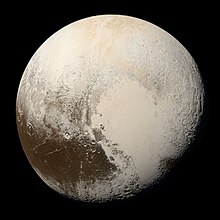 Pluto | |||||||
| Discovery | |||||||
|---|---|---|---|---|---|---|---|
| Discovered by: | Clyde W. Tombaugh | ||||||
| Discovery date: | February 18, 1930 | ||||||
| MPC designation: | 134340 Pluto | ||||||
| Minor planet category: |
| ||||||
| Orbital characteristics[೧][lower-alpha ೧] | |||||||
| Epoch J2000 | |||||||
| ಸೂರ್ಯನಿಂದ ಗರಿಷ್ಠ ದೂರ: |
| ||||||
| ಸೂರ್ಯನಿಂದ ಕನಿಷ್ಠ ದೂರ: |
| ||||||
| ದೀರ್ಘಾರ್ಧ ಅಕ್ಷ: |
| ||||||
| ಕಕ್ಷೀಯ ಕೇಂದ್ರ ಚ್ಯುತಿ: | 0.244671664 (J2000) 0.248 807 66 (mean)[೩] | ||||||
| ಪರಿಭ್ರಮಣ ಕಾಲ: | |||||||
| Synodic period: | 366.73 days[೩] | ||||||
| ಸರಾಸರಿ ಕಕ್ಷಾವೇಗ: | 4.7 km/s[೩] | ||||||
| Mean anomaly: | 14.86012204°[೫] | ||||||
| ಓರೆ: |
| ||||||
| Longitude of ascending node: | 110.28683° | ||||||
| Argument of perihelion: | 113.76349° | ||||||
| ನೈಸರ್ಗಿಕ ಉಪಗ್ರಹಗಳು: | 5 | ||||||
| Physical characteristics | |||||||
| Mean radius: | |||||||
| Surface area: |
| ||||||
| Volume: |
| ||||||
| Mass: |
| ||||||
| Mean density: | 2.03±0.06 g/cm3[೮] | ||||||
| Equatorial surface gravity: |
| ||||||
| Escape velocity: | ಟೆಂಪ್ಲೇಟು:V2 km/s[lower-alpha ೫] | ||||||
| Sidereal rotation period: |
| ||||||
| Rotation velocity at equator: | 47.18 km/h | ||||||
| Axial tilt: | 119.591°±0.014° (to orbit)[೮][lower-alpha ೬] | ||||||
| Right ascension of North pole: | 312.993°[೯] | ||||||
| Declination: | 6.163°[೯] | ||||||
| Albedo: | 0.49 to 0.66 (geometric, varies by 35%)[೩][೧೦] | ||||||
| Surface temp.: Kelvin |
| ||||||
| Apparent magnitude: | 13.65[೩] to 16.3[೧೧] (mean is 15.1)[೩] | ||||||
| Absolute magnitude: | −0.7[೧೨] | ||||||
| Angular size: | 0.065″ to 0.115″[೩][lower-alpha ೭] | ||||||
| Adjectives: | Plutonian | ||||||
| Atmosphere | |||||||
| Surface pressure: | 0.30 Pa (summer maximum) | ||||||
| Composition: | nitrogen, methane, carbon monoxide[೧೩] | ||||||

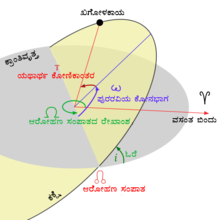
ಪರಿಚಯ
ಮೂಲತಃ ಗ್ರಹವೆಂದು ವಿಂಗಡಿಸಲಾಗಿದ ಪ್ಲುಟೊ ಪ್ರಸ್ತುತದಲ್ಲಿ ಕೈಪರ್ ಪಟ್ಟಿಯ ಅತಿ ದೊಡ್ಡ[೧೬] ಸದಸ್ಯವಾಗಿ ಪರಿಗಣಿಸಲ್ಪಡುತ್ತದೆ. ಕೈಪರ್ ಪಟ್ಟಿಯ ಬೇರೆ ಸದಸ್ಯಕಾಯಗಳಂತೆ ಪ್ಲೂಟೊ ಪ್ರಮುಖವಾಗಿ ಕಲ್ಲು ಮತ್ತು ಮಂಜಿನಿಂದ ಕೂಡಿದ್ದು, ಸುಮಾರು ಸಣ್ಣ ಗಾತ್ರದ್ದಾಗಿದೆ:
ಭೂಮಿಯ ಚಂದ್ರನ ದ್ರವ್ಯರಾಶಿಯ ಸುಮಾರು ಐದನೆ ಒಂದು ಪಾಲು ಮತ್ತು ಅದರ ಗಾತ್ರದ ಮೂರನೆ ಒಂದು ಪಾಲಿನಷ್ಟಿದೆ. ಇದರ ಕಕ್ಷೆಯು ಬಹಳಷ್ಟು ಉತ್ಕೇಂದ್ರೀಯತೆಯನ್ನು ಹೊಂದಿದ್ದು, ಪ್ಲೂಟೊವನ್ನು ಸೂರ್ಯನಿಂದ ೩೦-೪೯ ಖಗೋಳಮಾನ ದೂರಕ್ಕೆ (೪೪೦-೭೪೦ ಕೋಟಿ ಕಿ.ಮೀ.) ಕೊಂಡೊಯ್ಯುತ್ತದೆ. ಇದರ ಕಕ್ಷೆಯು ಹೆಚ್ಚಿನ ಓರೆಯನ್ನು ಹೊಂದಿರುವ ಕಾರಣ, ಪ್ಲೂಟೊ ಒಮ್ಮೊಮ್ಮೆ ನೆಪ್ಚೂನ್ಗಿಂತ ಸೂರ್ಯನ ಹತ್ತಿರಕ್ಕೆ ಬರುತ್ತದೆ.
೧೯೩೦ಯಲ್ಲಿ ಅದರ ಆವಿಷ್ಕಾರದಿಂದ ಹಿಡಿದು ೨೦೦೬ರ ವರೆಗೆ ಪ್ಲೂಟೊವನ್ನು ಸೌರಮಂಡಲದ ಒಂಭತ್ತನೆಯ ಗ್ರಹವೆಂದು ಪರಿಗಣಿಸಲಾಗಿತ್ತು. ೨೦ನೆ ಶತಮಾನದ ಕೊನೆಯ ಭಾಗದಲ್ಲಿ ಮತ್ತು ೨೧ನೆ ಶತಮಾನದ ಮೊದಲ ಭಾಗದಲ್ಲಿ, ಹೊರ ಸೌರಮಂಡಲದಲ್ಲಿ ಪ್ಲೂಟೊನಂತಹ ಹಲವು ಕಾಯಗಳು ಬೆಳಕಿಗೆ ಬಂದವು. ಇವುಗಳಲ್ಲಿ ಗಮನಾರ್ಹವಾದುದು ಪ್ಲೂಟೊಗಿಂತ ೨೭% ಹೆಚ್ಚು ಭಾರಿಯಿದ್ದು ಚದರಿದ ತಟ್ಟೆಯ ಕಾಯವಾಗಿರುವ ಎರಿಸ್.[೧೭]
ಆಗಸ್ಟ್ ೨೪, ೨೦೦೪ರಂದು ಮೊದಲಬಾರಿಗೆ ಅಂತರರಾಷ್ಟ್ರೀಯ ಖಗೋಳಶಾಸ್ತ್ರೀಯ ಸಂಸ್ಥೆಯು "ಗ್ರಹ" ಪದವನ್ನು ವ್ಯಾಖ್ಯಾನಿಸಿತು. ಈ ಹೊಸ ವ್ಯಾಖ್ಯಾನದೊಂದಿಗೆ ಪ್ಲುಟೊ ಒಂದು ಗ್ರಹವಾಗಿ ಉಳಿಯದೆ, ಅದನ್ನು ಎರಿಸ್ ಮತ್ತು ಸೆರೆಸ್ಗಳೊಂದಿಗೆ ಕುಬ್ಜಗ್ರಹವೆಂದು ವಿಂಗಡಿಸಲಾಯಿತು.[೧೮] ಈ ಮರುವಿಂಗಡಣೆಯ ನಂತರ ಪ್ಲುಟೊವನ್ನು ಕುಬ್ಜ ಗ್ರಹಗಳ ಪಟ್ಟಿಗೆ ಸೇರಿಸಿ, ಅದಕ್ಕೆ 134340 ಸಂಖ್ಯೆಯನ್ನು ಕೊಡಲಾಯಿತು.[೧೯][೨೦]
ಆವಿಷ್ಕಾರ
ಪ್ಲುಟೊದ ಆವಿಷ್ಕಾರವು ಒಂದು ತಪ್ಪು ತಿಳುವಳಿಕೆಯಿಂದ ಶುರುವಾಯಿತು. ವಿಜ್ಞಾನಿಗಳು ಗ್ರಹಗಳ ಕಕ್ಷೆಗಳನ್ನು ವಿಶ್ಲೇಷಿಸುವಾಗ, ಯುರೇನಸ್ನ ಕಕ್ಷೆಯು ತಮ್ಮ ಲೆಕ್ಕಾಚಾರಗಳಿಗೆ ಹೊಂದದಿರುವುದನ್ನು ಗಮನಿಸಿದರು. ಈ ಅಸಮಂಜಸತೆಗೆ ಕಾರಣ ಒಂದು ದೂರದ ಗ್ರಹದೊಂದಿಗಿನ ಗುರುತ್ವ ಒಡನಾಟಗಳು ಎಂದು ಮೊದಲು ಯೋಚಿಸಲಾಯಿತು. ಆದರೆ, ಪ್ಲುಟೊ ತನ್ನ ನೆರೆಯ ಗ್ರಹಗಳ ಕಕ್ಷೆಗಳ ಮೇಲೆ ಪ್ರಭಾವ ಬೀರುವಷ್ಟು ಭಾರಿಯಾಗಿಲ್ಲ. ಈ ಮೇಲಿನ ಅಸಮಂಜಸತೆಗೆ ಕಾರಣ, ನೆಪ್ಚೂನ್ನ ದ್ರವ್ಯರಾಶಿಯನ್ನು ಸರಿಯಾಗಿ ಅಂದಾಜು ಮಾಡದಿದ್ದುದು ಎಂದು ನಂತರ ತಿಳಿದುಬಂದಿತು.
Planet X
In the 1840s, using Newtonian mechanics, Urbain Le Verrier predicted the position of the then-undiscovered planet Neptune after analysing perturbations in the orbit of Uranus. Hypothesising that the perturbations were caused by the gravitational pull of another planet, Le Verrier sent his calculations to German astronomer Johann Gottfried Galle. On September 23, 1846, the night following his receipt of the letter, Galle and his student Heinrich d'Arrest found Neptune exactly where Le Verrier had predicted.[೨೧]
Observations of Neptune in the late 19th century caused astronomers to speculate that Uranus' orbit was being disturbed by another planet in addition to Neptune. In 1905, Percival Lowell, a wealthy Bostonian who had founded the Lowell Observatory in Flagstaff, Arizona in 1894, started an extensive project in search of a possible ninth planet, which he termed "Planet X".[೨೨] Lowell's hope in tracking down Planet X was to establish his scientific credibility, which had been dented by his widely derided belief that channel-like features visible on the surface of Mars were in fact canals constructed by an intelligent civilisation.[೨೩] By 1909, Lowell and William H. Pickering had suggested several possible celestial coordinates for such a planet.[೨೪] Lowell and his observatory conducted his search from 1905 until his death in 1916, but to no avail. Lowell's disappointment at not locating Planet X, according to one friend, "virtually killed him".[೨೫]
Constance Lowell, Percival Lowell's widow, subsequently embroiled the observatory in a decade-long legal battle to secure the observatory's million-dollar portion of Lowell's legacy for herself, which meant that its search for Planet X could not resume until 1929.[೨೬] In that year, the observatory's director, Vesto Melvin Slipher, summarily handed the job of locating Planet X to Clyde Tombaugh, a 22-year-old Kansas farm boy who had only just arrived at the Lowell Observatory after Slipher had been impressed by a sample of his astronomical drawings.[೨೬]
Tombaugh's task was systematically to image the night sky in pairs of photographs taken two weeks apart, then examine each pair and determine whether any objects had shifted position. Using a machine called a blink comparator, he rapidly shifted back and forth between views of each of the plates, to create the illusion of movement of any objects that had changed position or appearance between photographs. On February 18, 1930, after nearly a year of searching, Tombaugh discovered a possible moving object on photographic plates taken on January 23 and January 29 of that year. A lesser-quality photograph taken on January 20 helped confirm the movement. Tombaugh walked into Slipher's office and declared, "Doctor Slipher, I have found your Planet X."[೨೭] After the observatory obtained further confirmatory photographs, news of the discovery was telegraphed to the Harvard College Observatory on March 13, 1930. The new object would later be found on photographs dating back to March 19, 1915.[೨೪]
Naming
The right to name the new object belonged to the Lowell Observatory. Tombaugh urged Slipher to suggest a name for the new object quickly before someone else did.[೨೨] Name suggestions poured in from all over the world. Constance Lowell proposed Zeus, then Lowell, and finally her own first name. These suggestions were disregarded.[೨೮]
The name Pluto was first suggested by Venetia Burney (later Venetia Phair), an eleven-year-old schoolgirl in Oxford, ಇಂಗ್ಲೆಂಡ್.[೨೯] Venetia was interested in classical mythology as well as astronomy, and considered the name, one of the alternate names of Hades, the Greek god of the Underworld, appropriate for such a presumably dark and cold world. She suggested it in a conversation with her grandfather Falconer Madan, a former librarian of Oxford University's Bodleian Library. Madan passed the name to Professor Herbert Hall Turner, who then cabled it to colleagues in America.[೩೦]
The object was officially named on March 24, 1930.[೩೧] Each member of the Lowell Observatory was allowed to vote on a short-list of three: "Minerva" (which was already the name for an asteroid), "Cronus" (which had garnered a bad reputation after being suggested by an unpopular astronomer named Thomas Jefferson Jackson See), and Pluto. Pluto received every vote.[೩೨] The name was announced on May 1, 1930.[೨೯] Upon the announcement, Madan gave Venetia five pounds as a reward.[೨೯]
The name Pluto was intended to evoke the initials of the astronomer Percival Lowell, a desire echoed in the P-L monogram that is Pluto's astronomical symbol .[೩೩]Pluto's astrological symbol resembles that of Neptune ( ), but has a circle in place of the middle prong of the trident (
), but has a circle in place of the middle prong of the trident ( ).
).
In Chinese, Japanese, and Korean, the name was translated as underworld king star (冥王星),[೩೪] suggested by Houei Nojiri in 1930.[೩೫] In Vietnamese it is named after Yama (Sao Diêm Vương), the Guardian of Hell in Buddhist mythology. Yama (Devanāgarī यम) is also used in India, as it is the deity of Hell in Hindu mythologies.
Demise of Planet X
Once found, Pluto's faintness and lack of a resolvable disc cast doubt on the idea that it could be Lowell's Planet X. Throughout the mid-20th century, estimates of Pluto's mass were often revised downward. In 1978, the discovery of Pluto's moon Charon allowed the measurement of Pluto's mass for the first time. Its mass, roughly 0.2 percent that of the Earth, was far too small to account for the discrepancies in Uranus. Subsequent searches for an alternate Planet X, notably by Robert Harrington,[೩೬] failed. In 1993, Myles Standish used data from Voyager 2's 1989 flyby of Neptune, which had revised the planet's total mass downward by 0.5 percent, to recalculate its gravitational effect on Uranus. With the new figures added in, the discrepancies, and with them the need for a Planet X, vanished.[೩೭] Today the overwhelming consensus among astronomers is that Planet X, as Lowell defined it, does not exist. Lowell had made a prediction of Planet X's position in 1915 that was fairly close to Pluto's actual position at that time; however, Ernest W. Brown concluded almost immediately that this was a coincidence, a view still held today.[೩೮]
ಭೌತಿಕ ಗುಣಲಕ್ಷಣಗಳು
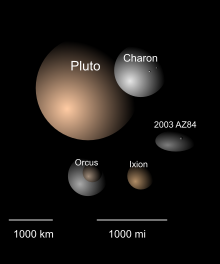

1. Frozen nitrogen
2. Water ice
3. Silicate and water ice
ಭೂಮಿಯಿಂದ ಪ್ಲೂಟೊ ದೂರವಿರುವ ಕಾರಣ, ಅದರ ಅಧ್ಯಯನವು ಕಷ್ಟಸಾಧ್ಯ. ೨೦೧೫ರಲ್ಲಿ ನವ ದಿಗಂತ ಗಗನನೌಕೆಯು ಪ್ಲುಟೊವನ್ನು ತಲುಪಿದ ಮೇಲೆ ಅದರ ಹಲವು ವಿವರಗಳು ತಿಳಿತುಬರುವ ಸಾಧ್ಯತೆಗಳಿವೆ..[೩೯]
ಗೋಚರತೆ ಮತ್ತು ರಚನೆ
ಪ್ಲೂಟೊದ ಗೋಚರ ಪ್ರಮಾಣವು ಸರಾಸರಿ ೧೫.೧ರಷ್ಟಿದ್ದು, ಪುರರವಿಯಲ್ಲಿ ಅದರ ಪ್ರಕಾಶತೆಯು ೧೩.೬೫ರವರೆಗೆ ಹೆಚ್ಚುತ್ತದೆ.[೩] ಇದನ್ನು ನೋಡಲು ದೂರದರ್ಶಕವು ಅತ್ಯಗತ್ಯ; ಸುಮಾರು ೩೦ ಸೆಂ.ಮೀ. ಕಿಂಡಿಯ ದೂರದರ್ಶಕವು ಅಪೇಕ್ಷಣೀಯ.[೪೦] ಇದರ ಕೋನವ್ಯಾಸವು ಕೇವಲ ೦.೧೧ ಅಂಗುಲಗಳಿರುವುದರಿಂದ, ದೊಡ್ಡ ದೂರದರ್ಶಕಗಳಲ್ಲೂ ಇದು ಮಬ್ಬಾದ ಮತ್ತು ಬಹು ದೂರದ ಒಂದು ನಕ್ಷತ್ರದಂತೆ ಕಾಣುತ್ತದೆ. ನೋಡಲು ಇದು ತಿಳಿ ಕಂದು ಬಣ್ಣದ್ದಾಗಿದ್ದು ಸ್ವಲ್ಪವೇ ಹಳದಿ ಸಹ ಇದರಲ್ಲಿ ಸೇರಿದೆ.[೪೧]
ಪ್ಲೂಟೊದ ಮೇಲ್ಮೈಯು ೯೮% ಕ್ಕಿಂತ ಹೆಚ್ಚು ಸಾರಜನಕದ ಮಂಜು, ಮತ್ತು ಅಲ್ಪಪ್ರಮಾಣದಲ್ಲಿ ಮೀಥೇನ್ ಮತ್ತು ಇಂಗಾಲದ ಮಾನಾಕ್ಸೈಡುಗಳಿಂದ ಕೂಡಿದೆಯೆಂದು ಮೇಲ್ಮೈನ ರೋಹಿತದರ್ಶಕೀಯ ವಿಶ್ಲೇಷಣೆಗಳಿಂದ ತಿಳಿದುಬರುತ್ತದೆ.[೪೨][೪೩] ಪ್ಲುಟೊದ ದೂರ ಮತ್ತು ಪ್ರಸ್ತುತದಲ್ಲಿನ ದೂರದರ್ಶಕಗಳ ಮಿತಿಗಳ ಕಾರಣದಿಂದ, ಪ್ಲುಟೊದ ಮೇಲ್ಮೈ ರಚನೆಗಳನ್ನು ನೇರವಾಗಿ ಛಾಯಾಚಿತ್ರಗಳಿಂದ ಸೆರೆಹಿಡಿಯಲು ಅಸಾಧ್ಯ. ಹಬಲ್ ದೂರದರ್ಶಕದಿಂದ ಫಲಿತ ಚಿತ್ರಗಳು ಮೇಲ್ಮೈನ ಯಾವುದೇ ಸೂಕ್ಷ್ಮ ವಿವರಣೆಗಳು ಕಾಣಬರುವುದಿಲ್ಲ.[೪೪]
ಗ್ರಹದ ಅತಿ ದೊಡ್ಡ ಉಪಗ್ರಹವಾದ ಶಾರನ್ನೊಂದಿಗೆ ಪ್ಲೂಟೊದ ಗ್ರಹಣಗಳ ಸೂಕ್ಷ್ಮ ವೀಕ್ಷಣೆಗಳಿಂದ ಹೊರಬಂದಿರುವ ಪ್ಲುಟೊದ ಪ್ರಕಾಶತೆ ನಕ್ಷೆಗಳೇ ಇರುವುದರಲ್ಲಿ ಪ್ಲುಟೊದ ಅತ್ಯುತ್ತಮ ಚಿತ್ರಗಳು. ಪ್ಲೂಟೊ ಶಾರನ್ನ ಹಿಂದೆ ಗ್ರಹಣದಲ್ಲಿ ಮರೆಯಾಗುತ್ತಿದ್ದಂತೆ ತೋರುವ ಪ್ರಕಾಶತೆಯ ವ್ಯತ್ಯಾಸಗಳನ್ನು ಗಣಕಯಂತ್ರದಲ್ಲಿ ಸಂಸ್ಕರಿಸಿ ಅಧ್ಯಯಿಸಲಾಗುತ್ತದೆ. ಉದಾಹರಣೆಗೆ, ಪ್ಲೂಟೊದ ಒಂದು ತಿಳಿ ವಲಯವು ಗ್ರಹಣಕ್ಕೊಳಗಾದಾಗ ಒಟ್ಟು ಪ್ರಕಾಶತೆಯಲ್ಲಿ ಹೆಚ್ಚಿನ ವ್ಯತ್ಯಾಸವುಂಟಾಗುತ್ತದೆ. ಆದರೆ, ಗಾಢ ವಲಯವೊಂದು ಗ್ರಹಣಕ್ಕೊಳಗಾದಾಗ ಅಷ್ಟೊಂದು ವ್ಯತ್ಯಾಸ ವಾಗುವುದಿಲ್ಲ. ಈ ಕಾರ್ಯವಿಧಾನವನ್ನು ಬಳಸಿ ಪ್ಲೂಟೊ-ಶಾರನ್ ವ್ಯವಸ್ಥೆಯ ಒಟ್ಟು ಪ್ರಕಾಶತೆಯನ್ನು ಮಾಪಿಸಬಹುದು.[೪೫] ಹಬಲ್ ದೂರದರ್ಶಕವು ಒದಗಿಸಿದ ನಕ್ಷೆಗಳಿಂದ ಪ್ಲೂಟೊದ ಮೇಲ್ಮೈಯು ಗಮನಾರ್ಹವಾಗಿ ವೈವಿಧ್ಯಮಯವಾಗಿದೆ ಎಂದು ತೋರುತ್ತದೆ. ಈ ಸಂಗತಿಯು ಅದರ ಅವೆಗೆಂಪು ರೋಹಿತದಲ್ಲಿ ಆವರ್ತಿಸುವ ಬದಲಾವಣೆಗಳಿಂದಲೂ ತಿಳಿಯುತ್ತದೆ. ಶಾರನ್ನ ಕಡೆಗೆ ತಿರುಗಿರುವ ಪ್ಲೂಟೊದ ಮೇಲ್ಮೈಯು ಹೆಚ್ಚಾಗಿ ಮೀಥೇನ್ ಮಂಜಿನಿಂದ ಕೂಡಿದ್ದು, ಅದರ ವಿರುದ್ಧ ಕಡೆಯ ಮೇಲ್ಮೈಯು ಹೆಚ್ಚು ಸಾರಜನಕ ಮತ್ತು ಇಂಗಾಲದ ಮಾನಾಕ್ಸೈಡ್ಗಳನ್ನು ಹೊಂದಿರುತ್ತದೆ. ಇದರಿಂದ, ಪ್ಲೂಟೊ ಸೌರಮಂಡಲದಲ್ಲಿ ಎರಡನೇ ಅತಿ ಹೆಚ್ಚು ವೈದೃಶ್ಯಿತ ಕಾಯವಾಗಿದೆ (ಲಪೀಟಸ್ ಉಪಗ್ರಹದ ನಂತರ).[೪೬]
ಹಬಲ್ ದೂರದರ್ಶಕದ ಅಂದಾಜಿನ ಪ್ರಕಾರ ಪ್ಲೂಟೊದ ಸಾಂದ್ರತೆಯು ೧.೮ ರಿಂದ ೨.೧ ಗ್ರಾಂ./ಸೆಂ.ಮೀ.೩ ನಷ್ಟು ಇದೆ; ಇದರಿಂದ, ಪ್ಲೂಟೊದ ಆಂತರಾಳವು ಸುಮಾರು ೫೦-೭೦% ಶಿಲೆಗಳು ಮತ್ತು ೩೦-೫೦% ಮಂಜುಗಳಿಂದ ರಚಿತ ವಾಗಿರಬಹುದೆಂದು ತಿಳಿದು ಬರುತ್ತದೆ.[೪೩] ಒಳಭಾಗದ ಮಂಜು ವಿಕಿರಣಪಟು ಖನಿಜಗಳ ಕ್ಷಯದಿಂದ ಬಿಸಿಯಾಗುತ್ತದೆ. ಹೀಗಾಗಿ ಕಡೆಗೆ ಮಂಜು ಮತ್ತು ಶಿಲೆಗಳು ಬೇರ್ಪಡುತ್ತವೆ. ಇದರ ಕಾರಣದಿಂದ ಪ್ಲುಟೊದ ಆಂತರಿಕ ರಚನೆಯು ವಿಭೇದಿತ ವಾಗಿದ್ದು, ಶಿಲೆಗಳು ಸಾಂದ್ರವಾದ ಒಳಗರ್ಭವನ್ನು ರೂಪಿಸಿದರೆ, ಮಂಜಿನ ಪದಾರ್ಥಗಳು ಕವಚವನ್ನು ರೂಪಿಸುತ್ತವೆ. ಈ ರೀತಿಯ ಶಾಖೋತ್ಪನ್ನವು ಇಂದಿಗೂ ನಡೆಯುತ್ತಿರಬಹುದು ಹಾಗೂ ಇದರಿಂದ ಪ್ಲುಟೊದ ಮೇಲ್ಮೈನ ಕೆಳಗೆ ಒಂದು ದ್ರವೀಕೃತ ನೀರಿನ ಸಾಗರವು ಉಂಟಾಗಿರ ಬಹುದು.
ದ್ರವ್ಯರಾಶಿ ಮತ್ತು ಗಾತ್ರ

೧೯೫೫ರಲ್ಲಿ ಪ್ಲೂಟೊದ ದ್ರವ್ಯರಾಶಿಯು ಸುಮಾರು ಭೂಮಿಯಷ್ಟೇ ಇದೆಯೆಂದು ಅಂದಾಜು ಮಾಡಲಾಯಿತು. ೧೯೭೧ರಲ್ಲಿ ನಡೆದ ಹೆಚ್ಚಿನ ಲೆಕ್ಕಾಚಾರಗಳ ಕಾರಣದಿಂದ ಪ್ಲೂಟೊದ ದ್ರವ್ಯರಾಶಿಯು ಮಂಗಳ ಗ್ರಹದಷ್ಟಿರಬಹುದೆಂದು ಅಂದಾಜು ಮಾಡಲಾಯಿತು.[೪೭] ಆದರೆ, ೧೯೭೬ರಲ್ಲಿ ಪ್ಲೂಟೊದ ಪ್ರತಿಫಲನಾಂಶದ ಪ್ರಮಾಣವು ತಿಳಿದುಬಂದ ಮೇಲೆ, ಅದು ಮೀಥೇನ್ ಮಂಜಿನಿಂದ ಕೂಡಿರಬೇಕೆಂದು ತಿಳಿಯಿತು; ಇದರರ್ಥ ಪ್ಲೂಟೊ ತನ್ನ ಗಾತ್ರಕ್ಕೆ ಹೋಲಿಸಿದರೆ ಅಪಾರ ಪ್ರಕಾಶತೆಯನ್ನು ಹೊಂದಿರಬೇಕಿತ್ತು. ಹೀಗಾಗಿ, ಅದರ ದ್ರವ್ಯರಾಶಿಯು ಭೂಮಿಯ ೧%ಗಿಂತ ಹೆಚ್ಚಾಗಿರಲು ಸಾಧ್ಯವಿರಲಿಲ್ಲ.[೪೭][೪೮]
೧೯೭೮ರಲ್ಲಿ ಪ್ಲೂಟೊದ ಉಪಗ್ರಹವಾದ ಶಾರನ್ನ ಆವಿಷ್ಕಾರದೊಂದಿಗೆ, ಕೆಪ್ಲರ್ನ ಮೂರನೆ ನಿಯಮದ ನ್ಯೂಟನ್ನ ನಿರೂಪಣೆಯನ್ನು ಬಳಸಿ ಪ್ಲೂಟೊ-ಶಾರನ್ ವ್ಯವಸ್ಥೆಯ ದ್ರವ್ಯರಾಶಿಯನ್ನು ಕಂಡುಹಿಡಿಯಲಾಯಿತು. ಪ್ಲೂಟೊದ ಮೇಲೆ ಶಾರನ್ನ ಗುರುತ್ವ ಪ್ರಭಾವವನ್ನು ಮಾಪಿಸಲಾದ ಮೇಲೆ ಪ್ಲೂಟೊದ ದ್ರವ್ಯರಾಶಿಯ ಅಂದಾಜುಗಳು ೧.೩೧×೧೦೨೨ kg—ಭೂಮಿಯ ದ್ರವ್ಯರಾಶಿಯ ೦.೨೪% ಗಿಂತ ಕಡಿಮೆಯಷ್ಟು ಕೆಳಬಿದ್ದವು.[೪೯] ಶಾರನ್ ಪ್ಲೂಟೊವನ್ನು ಮರೆಮಾಡಿದ್ದನ್ನು ವೀಕ್ಷಿಸಿ, ಪ್ಲೂಟೊದ ವ್ಯಾಸವು ಸುಮಾರು ೨,೩೯೦ ಕಿ.ಮೀ. ಎಂದು ನಿರ್ಧರಿಸಲಾಯಿತು.[೫೦] en:adaptive opticsನ ಆವಿಷ್ಕರಣದ ನಂತರ ಖಗೋಳಶಾಸ್ತ್ರಜ್ಞರು ಅದರ ಆಕಾರವನ್ನು ಹೆಚ್ಚು ನಿಖರವಾಗಿ ನಿರ್ಧರಿಸಿದರು.[೫೧]
ಸೌರಮಂಡಲದ ಕಾಯಗಳಲ್ಲಿ ಪ್ಲೂಟೊ ಬೇರೆಲ್ಲ ಗ್ರಹಗಳಿಗಿಂತ ಬಹಳ ಸಣ್ಣದು ಮತ್ತು ಹಗುರವಾಗಿದೆ. ಇದಲ್ಲದೆ, ಚಂದ್ರನ ೨೦% ದ್ರವ್ಯರಾಶಿಯನ್ನು ಹೊಂದಿರುವ ಪ್ಲೂಟೊ ಸೌರಮಂಡಲದ ಏಳು ಸ್ವಾಭಾವಿಕ ಉಪಗ್ರಹಗಳಿಗಿಂತಲೂ ಸಣ್ಣದಾಗಿದೆ: ಗ್ಯಾನಿಮಿಡ್, ಟೈಟನ್, ಕ್ಯಾಲಿಸ್ಟೊ, ಐಒ, ಭೂಮಿಯ ಚಂದ್ರ, ಯೂರೋಪ ಮತ್ತು ಟ್ರಿಟಾನ್. ಕ್ಷುದ್ರಗ್ರಹ ಹೊನಲಿನಲ್ಲಿ ಒಂದು ಕುಬ್ಜ ಗ್ರಹವಾದ ೧ ಸಿರಿಸ್ನ ಎರಡರಷ್ಟು ವ್ಯಾಸ ಮತ್ತು ೧೨ ಪಟ್ಟು ದ್ರವ್ಯರಾಶಿಯನ್ನು ಹೊಂದಿರುವ ಪ್ಲೂಟೊ, ೨೦೦೫ರಲ್ಲಿ ಕಂಡು ಹಿಡಿಯಲಾದ ನೆಪ್ಚೂನ್ಅತೀತ ಕಾಯ ಏರಿಸ್ಗಿಂತ ಚಿಕ್ಕದಾಗಿದೆ.
ವಾಯುಮಂಡಲ
ಪ್ಲೂಟೊದ ವಾಯುಮಂಡಲವು ಸಾರಜನಕ, ಮೀಥೇನ್ ಮತ್ತು ಇಂಗಾಲದ ಮಾನಾಕ್ಸೈಡ್ಗಳ ವಿರಳ ಲೇಪನದಿಂದ ಕೂಡಿದ್ದು, ಈ ಅನಿಲಗಳು ಗ್ರಹದ ಮೇಲ್ಮೈನ ಮಂಜಿನಿಂದ ಉದ್ಭವಿಸುತ್ತವೆ.[೫೨] ಪ್ಲೂಟೊ ತನ್ನ ಪರಿಭ್ರಮಣೆಯ ಕಾಲದಲ್ಲಿ ಸೂರ್ಯನಿಂದ ಹೆಚ್ಚು ದೂರಕ್ಕೆ ಸರಿದಂತೆ ಅದರ ವಾಯುಮಂಡಲವು ನಿಧಾನವಾಗಿ ಘನೀಕರಿಸಿ ನೆಲದ ಮೇಲೆ ಬೀಳುತ್ತದೆ. ಪ್ಲೂಟೊ ಸೂರ್ಯನಿಗೆ ಹೆಚ್ಚು ಹತ್ತಿರ ಬಂದಂತೆ ಅದರ ಘನ ಮೇಲ್ಮೈನ ತಾಪಮಾನವು ಹೆಚ್ಚಿ ಮಂಜು ಅನಿಲವಾಗಿ ಉತ್ಪನನ. ಬೆವರು ನಮ್ಮ ಮೈ ತಂಪಾಗುವಂತೆ ಈ ಪ್ರಕ್ರಿಯೆಯಿಂದ ಪ್ಲುಟೊದ ಮೇಲ್ಮೈ ಸಹ ಇನ್ನೂ ತಣ್ಣಗಾಗುತ್ತದೆ. ಉಪಮಿಲಿಮೀಟರ್ ವ್ಯೂಹವನ್ನು ಬಳಸಿ ಪ್ಲೂಟೊದ ತಾಪಮಾನವು ೪೩K ಅಥವ, ನಿರೀಕ್ಷೆಗಿಂತ ೧೦K ಕಡಿಮೆಯಿದೆ ಎಂದು ವಿಜ್ಞಾನಿಗಳು ಇತ್ತೀಚೆಗೆ ಕಂಡು ಹಿಡಿದಿದ್ದಾರೆ.[೫೩]
೧೯೮೫ಯಲ್ಲಿ ಒಂದು ಮರೆಮಾಡುವಿಕೆಯ ವೀಕ್ಷಣೆಯಿಂದ, ಪ್ಲೂಟೊ ವಾಯುಮಂಡಲವನ್ನು ಹೊಂದಿರುವ ಸಂಗತಿಯು ಬೆಳಕಿಗೆ ಬಂದಿತು; ೧೯೯೮ರಲ್ಲಾದ ಮತ್ತೊಂದು ಮರೆಮಾಡುವಿಕೆಯ ವ್ಯಾಪಕ ವೀಕ್ಷಣೆಗಳಿಂದ ಈ ಸಂಗತಿಯು ದೃಢೀಕೃತವಾಯಿತು. ವಾಯುಮಂಡಲವಿಲ್ಲದ ಒಂದು ಕಾಯವು ಒಂದು ನಕ್ಷತ್ರವನ್ನು ಮರೆಮಾಡುವಾಗ, ನಕ್ಷತ್ರವು ತತ್ಕ್ಷಣ ಮರೆಯಾಗಿ ಹೋಗುತ್ತದೆ; ಪ್ಲೂಟೊದ ಸನ್ನಿವೇಶದಲ್ಲಿ ನಕ್ಷತ್ರವು ನಿಧಾನವಾಗಿ ಮಬ್ಬಾಯಿತು.[೫೪] ಮಬ್ಬಾಗುವ ದರವನ್ನಾಧರಿಸಿ, ವಾಯು ಒತ್ತಡವು ೦.೧೫ Pa, ಅಥವ ಭೂಮಿಯ ೭೦೦,೦೦೦ನೇ ೧ರಷ್ಟು ಎಂದು ನಿರ್ಧರಿಸಲಾಯಿತು.[೫೫]
In 2002, another occultation of a star by Pluto was observed and analysed by teams led by Bruno Sicardy of the Paris Observatory[೫೬], James L. Elliot of MIT[೫೭], and Jay Pasachoff of Williams College.[೫೮] The atmospheric pressure was estimated to be 0.3 pascal, even though Pluto was farther from the Sun than in 1988 and thus should have been colder and had a more rarefied atmosphere. One explanation for the discrepancy is that in 1987 the south pole of Pluto came out of shadow for the first time in 120 years, causing extra nitrogen to sublimate from the polar cap. It will take decades for the excess nitrogen to condense out of the atmosphere.[೫೯] Another stellar occultation was observed by the MIT-Williams College team of James Elliot, Jay Pasachoff, and a Southwest Research Institute team led by Leslie Young on 12 June, 2006 from sites in Australia.[೬೦]
ಅಕ್ಟೋಬರ್ ೨೦೦೬ರಲ್ಲಿ ನಾಸಾ/ಏಮ್ಸ್ ಸಂಶೋಧನಾ ಕೇಂದ್ರವು ಪ್ಲೂಟೊದ ಮೇಲ್ಮೈನಲ್ಲಿ ಈಥೇನ್ನ ಅಸ್ತಿತ್ವವನ್ನು ವರ್ಣಪಟಲಮಾಪನದಿಂದ ಕಂಡುಹಿಡಿಯಿತು. ಪ್ಲುಟೊದ ಮೇಲ್ಮೈನಲ್ಲಿ ಘನೀಕೃತ ಮೀಥೇನ್ನ ದ್ಯುತಿವಿಶ್ಲೇಷಣೆ ಮತ್ತು ವಿಕಿರಣವಿಶ್ಲೇಷಣೆಗಳಿಂದ (ಅಂದರೆ, ಸೂರ್ಯನ ಬೆಳಕು ಮತ್ತು ಆವೇಷಿತ ಕಣಗಳಿಂದ ಪ್ರೇರಿತ ರಸಾಯನಿಕ ಪರಿವರ್ತನೆ) ಈಥೇನ್ ಉತ್ಪತ್ತಿಯಾಗಿ ವಾಯುಮಂಡಲದಲ್ಲಿ ತೇಲುತ್ತದೆ.[೬೧]
ಕಕ್ಷೆ

ಪ್ಲೂಟೊದ ಕಕ್ಷೆಯು ಬೇರೆ ಗ್ರಹಗಳಿಗಿಂತ ಗಮನಾರ್ಹವಾಗಿ ಭಿನ್ನವಾಗಿದೆ. ಬೇರೆಲ್ಲಾ ಗ್ರಹಗಳೂ ಸೂರ್ಯನನ್ನು ಕ್ರಾಂತಿವೃತ್ತ ಎಂದು ಕರೆಯಲಾಗುವ ಒಂದು ನಿರ್ದೇಶಕ ಸಮತಳದಲ್ಲಿ ಪರಿಭ್ರಮಿಸುತ್ತವೆ ಮತ್ತು ಸುಮಾರು ವೃತ್ತಾಕಾರದ ಕಕ್ಷೆಗಳನ್ನು ಹೊಂದಿವೆ. ಹೋಲಿಕೆ ಯಲ್ಲಿ, ಪ್ಲೂಟೊದ ಕಕ್ಷೆಯು ಕ್ರಾಂತಿವೃತ್ತಕ್ಕೆ ಸಾಪೇಕ್ಷವಾಗಿ ಹೆಚ್ಚಿನ ಓರೆಯನ್ನು ಹೊಂದಿದ್ದು (೧೭° ಗಿಂತ ಹೆಚ್ಚು), ಹೆಚ್ಚಿನ ಕಕ್ಷೀಯ ಉತ್ಕೇಂದ್ರೀಯತೆಯನ್ನೂ ಹೊಂದಿದೆ. ಈ ಉತ್ಕೇಂದ್ರೀಯತೆಯ ಕಾರಣ, ಪ್ಲೂಟೊದ ಕಕ್ಷೆಯ ಒಂದು ಸಣ್ಣ ಭಾಗವು ನೆಪ್ಚೂನ್ ಗ್ರಹದ ಕಕ್ಷೆಗಿಂತ ಸೂರ್ಯನಿಗೆ ಹತ್ತಿರದಲ್ಲಿರುತ್ತದೆ. ಪ್ಲೂಟೊವು ಈ ರೀತಿ ಹಿಂದೆ ಫೆಬ್ರವರಿ ೭, ೧೯೭೯ ಮತ್ತು ಫೆಬ್ರವರಿ ೧೧, ೧೯೯೯ಗಳ ನಡುವೆ ನೆಪ್ಚೂನ್ನ ಕಕ್ಷೆಯ ಒಳಗಿತ್ತು.
ದೀರ್ಘಾವಧಿಯಲ್ಲಿ ಪ್ಲೂಟೊದ ಕಕ್ಷೆಯು ಗೊಂದಲಮಯವಾಗಿದೆ. ಗಣಕಯಂತ್ರ ಛದ್ಮನಗಳಿಂದ ಪ್ಲುಟೊದ ಕಕ್ಷೆಯನ್ನು ಮುಂದಿನ ಹಲವು ದಶಲಕ್ಷ ವರ್ಷಗಳವರೆಗೆ ಕಂಡು ಹಿಡಿಯಬಹುದಾದರೂ, ಸುಮಾರು ೧-೨ ಕೋಟಿ ವರ್ಷಗಳ ನಂತರ ಪ್ಲುಟೊದ ಕಕ್ಷೆಯನ್ನು ವಿವರಿಸಲಾಗುವುದಿಲ್ಲ.[೬೨][೬೩] ಉದಾಹರಣೆಗೆ, ಈಗಿನಿಂದ ಒಂದು ಕೋಟಿ ವರ್ಷಗಳ ನಂತರ ಒಂದು ನಿಗದಿತ ಸಮಯದಲ್ಲಿ ಪ್ಲೂಟೊ ಪುರರವಿ ಅಥವ ಅಪರವಿಯಲ್ಲಿ (ಅಥವ ಅವೆರಡರ ನಡುವೆ) ಇರಬಹುದು. ಇದನ್ನು ಈಗಲೇ ನಿಖರವಾಗಿ ಕಂಡು ಹಿಡಿಯಲು ಅಸಾಧ್ಯ. ಆದರೆ ಇದರರ್ಥ ಪ್ಲೂಟೊದ ಕಕ್ಷೆಯು ಅಸ್ಥಿರವೆಂದಲ್ಲ. ವಾಸ್ತವದಲ್ಲಿ ಹಲವು ಅನುರಣನೆಗಳು ಪ್ಲೂಟೊದ ಕಕ್ಷೆಯನ್ನು ಸ್ಥಿರಗೊಳಿಸಿ, ಗ್ರಹಗಳು ಒಂದಕ್ಕೊಂದು ಅಪ್ಪಳಿಸದಂತೆ ನೋಡಿಕೊಳ್ಳುತ್ತವೆ.
ನೆಪ್ಚೂನ್-ತಪ್ಪಿಸುವ ಕಕ್ಷೆ

ಕ್ರಾಂತಿವೃತ್ತದ ಮೇಲಿನಿಂದ ನೇರ ಕೆಳಗೆ ನೋಡಿದಾಗ, ಪ್ಲೂಟೊದ ಕಕ್ಷೆಯು ನೆಪ್ಚೂನ್ನ ಕಕ್ಷೆಯನ್ನು ಛೇದಿಸುವಂತೆ ಕಂಡರೂ, ಈ ಎರಡು ಕಾಯಗಳು ಡಿಕ್ಕಿ ಹೊಡೆಯಲಾರವು. ಪ್ಲೂಟೊ ಮತ್ತು ನೆಪ್ಚೂನ್ಗಳು ಸಮೀಪದಲ್ಲೂ ಹಾದುಹೋಗದಂತೆ ಅವುಗಳ ಕಕ್ಷೆಗಳು ಹೊಂದಿ ಕೊಂಡಿರುವುದೇ ಇದಕ್ಕೆ ಕಾರಣ. ಹಲವು ಅಂಶಗಳು ಈ ಪರಿಣಾಮಕ್ಕೆ ಎಡೆ ಮಾಡಿಕೊಡುತ್ತವೆ.
ಈ ಎರಡು ಕಕ್ಷೆಗಳನ್ನು ಸರಳವಾದ ವೀಕ್ಷಣೆಗೊಳಪಡಿಸಿ ಇವೆರಡು ಛೇದಿಸಲಾರವೆಂಬುದನ್ನು ಕಂಡುಕೊಳ್ಳಬಹುದು. ಪ್ಲೂಟೊ ಸೂರ್ಯನಿಗೆ ಅತಿ ಹತ್ತಿರದಲ್ಲಿದ್ದಾಗ (ಹೀಗಿದ್ದಾಗ ಮೇಲಿನಿಂದ ಕೆಳಗೆ ನೋಡಿದಂತೆ ಇದು ನೆಪ್ಚೂನ್ನ ಕಕ್ಷೆಗೂ ಅತಿ ಹತ್ತಿರದಲ್ಲಿರುತ್ತದೆ) ಕ್ರಾಂತಿವೃತ್ತದ ಅತ್ಯಂತ ಮೇಲೆ ಇರುತ್ತದೆ. ಹೀಗಾಗಿ, ಪ್ಲೂಟೊದ ಕಕ್ಷೆಯು ನೆಪ್ಚೂನ್ನ "ಮೇಲೆ" ಹಾದುಹೋಗುತ್ತದೆ.[೬೪] ವಾಸ್ತವದಲ್ಲಿ, ನೆಪ್ಚೂನ್ ಇರುವುದಕ್ಕಿಂತ ಸೂರ್ಯನಿಗೆ ಹತ್ತಿರದಲ್ಲಿರುವ ಪ್ಲೂಟೊದ ಕಕ್ಷೆಯ ಭಾಗವು ಕ್ರಾಂತಿವೃತ್ತದ ಮೇಲೆ ಸುಮಾರು ೮ ಖಮಾ. ದೂರದಲ್ಲಿ,[೬೫] ಹಾಗೂ ನೆಪ್ಚೂನ್ನ ಕಕ್ಷೆಯ ಮೇಲೆ ಸುಮಾರು ಅಷ್ಟೇ ದೂರದಲ್ಲಿ ಇರುತ್ತದೆ.[೬೬] ಪ್ಲುಟೊದ ಆರೋಹಣ ಸಂಪಾತವು (ಪ್ಲೂಟೊದ ಕಕ್ಷೆಯು ಕ್ರಾಂತಿವೃತ್ತವನ್ನು ಛೇದಿಸುವ ಬಿಂದು) ಪ್ರಸ್ತುತದಲ್ಲಿ ನೆಪ್ಚೂನ್ನಿಂದ ೨೧°ಗೂ ಹೆಚ್ಚು ಬೇರ್ಪಡಿಕೆಯಲ್ಲಿದೆ;[೬೭] ಅವುಗಳ ಅವರೋಹಣ ಸಂಪಾತಗಳೂ ಸುಮಾರು ಇಷ್ಟೇ ಬೇರ್ಪಡಿಕೆಯಲ್ಲಿವೆ (ಚಿತ್ರವನ್ನು ನೋಡಿ). ಕ್ರಾಂತಿವೃತ್ತಕ್ಕೆ ಸಾಪೇಕ್ಷವಾಗಿ ನೆಪ್ಚೂನ್ನ ಕಕ್ಷೆಯು ಬಹಳಷ್ಟು ಕ್ರಾಂತಿವೃತ್ತದ ಮಟ್ಟದಲ್ಲೇ ಇರುವುದರಿಂದ, ಎರಡು ಕಾಯಗಳ ಕಕ್ಷೆಗಳು ಛೇದಿಸುವಷ್ಟರಲ್ಲಿ ಪ್ಲುಟೊ ಕ್ರಾಂತಿವೃತ್ತದ ಸಾಕಷ್ಟು ಮೇಲಿರುತ್ತದೆ.
ಪ್ಲೂಟೊವನ್ನು ರಕ್ಷಿಸಲು ಇದೊಂದೇ ಸಾಲದು; ಗ್ರಹಗಳಿಂದ (ಗಮನಾರ್ಹವಾಗಿ, ನೆಪ್ಚೂನ್ನಿಂದ) ಉಂಟಾಗುವ ಕ್ಷೋಭೆಗಳು (ಉದಾ: ಕಕ್ಷೀಯ ಅಯನ) ಪ್ಲೂಟೊದ ಕಕ್ಷೆಯನ್ನು ಬದಲಿಸಿ, ಕೋಟ್ಯಾಂತರ ವರ್ಷಗಳಲ್ಲಿ ಅಪ್ಪಳಿಕೆಯನ್ನುಂಟು ಮಾಡಬಹುದು. ಆದ್ದರಿಂದ ಇದರ ಹಿಂದೆ ಬೇರೆ ಪ್ರಕ್ರಿಯೆ ಅಥವ ಪ್ರಕ್ರಿಯೆಗಳು ಕೆಲಸ ಮಾಡುತ್ತಿರಬೇಕು. ಇವುಗಳಲ್ಲಿ ಅತಿ ಗಮನಾರ್ಹವಾದುದು ಪ್ಲೂಟೊ (ಕೆಂಪು) ಮತ್ತು ನೆಪ್ಚೂನ್ಗಳ (ನೀಲಿ) ಸಾಪೇಕ್ಷ ಸ್ಥಿತಿಗಳನ್ನು ಈ ಚಿತ್ರವು ತೋರುತ್ತದೆ. ೧೮೯೬ರ ಅತಿ ಸಾಮೀಪ್ಯದ ಹಾಯುವಿಕೆಯನ್ನು ಒತ್ತಿ ತೋರಿಸುವ ಸಲುವಾಗಿ ಪ್ಲೂಟೊ ಮತ್ತು ನೆಪ್ಚೂನ್ಗಳ ಗಾತ್ರವನ್ನು ಅವುಗಳ ನಡುವಣ ದೂರಕ್ಕೆ ವಿಲೋಮವಾಗಿ ನಿರೂಪಿಸಲಾಗಿದೆ.]]
ಪ್ಲೂಟೊ ನೆಪ್ಚೂನ್ ಗ್ರಹದ ೩:೨ ಸರಾಸರಿ ಚಲನಾ ಅನುರಣನೆಯಲ್ಲಿದೆ: ನೆಪ್ಚೂನ್ ಸೂರ್ಯನ ಸುತ್ತ ಮಾಡುವ ಪ್ರತಿ ೩ ಪರಿಭ್ರಮಣೆಗಳಿಗೆ, ಪ್ಲೂಟೊ ೨ ಪರಿಭ್ರಮಣೆಗಳನ್ನು ಮಾಡುತ್ತದೆ. ತದನಂತರ ಈ ಎರಡು ಕಾಯಗಳು ತಮ್ಮ ಮೊದಲ ಸ್ಥಿತಿಗೇ ಮರಳಿ, ಈ ಚಲನೆಯು ಪುನರಾವರ್ತಿಸುತ್ತದೆ. ಈ ರೀತಿಯ ಪ್ರತಿ ಆವರ್ತವು ಸುಮಾರು ೫೦೦ ವರ್ಷಗಳ ಕಾಲ ನಡೆಯುತ್ತದೆ. ಈ ಚಲನೆಯ ವಿನ್ಯಾಸದ ಪ್ರಕಾರ, ಪ್ರತಿ ೫೦೦ ವರ್ಷಗಳ ಆವರ್ತದಲ್ಲಿ, ಪ್ಲೂಟೊ ಮೊದಲ ಬಾರಿಗೆ ಪುರರವಿಯಲ್ಲಿದ್ದಾಗ, ನೆಪ್ಚೂನ್ ಪ್ಲೂಟೊಗೆ ಸುಮಾರು ೫೦° ಯಷ್ಟು "ಹಿಂದೆ" ಇರುತ್ತದೆ.
ಪ್ಲೂಟೊದ ಎರಡನೇ ಪುರರವಿಯ ಹೊತ್ತಿಗೆ ನೆಪ್ಚೂನ್ ತನ್ನ ಒಂದೂವರೆ ಪರಿಭ್ರಮಣೆಗಳನ್ನು ಮುಗಿಸಿ, ಸುಮಾರು ೫೦° ಗಳಷ್ಟೇ ಪ್ಲೂಟೊದ "ಮುಂದೆ" ಇರುತ್ತದೆ. ವಾಸ್ತವದಲ್ಲಿ ಪ್ಲೂಟೊ ಮತ್ತು ನೆಪ್ಚೂನ್ಗಳ ನಡುವಣ ಕನಿಷ್ಠ ಬೇರ್ಪಡಿಕೆಯು ೧೭ ಖ.ಮಾ ಕ್ಕಿಂತ ಹೆಚ್ಚು; ಇಷ್ಟೇ ಅಲ್ಲದೆ, ಪ್ಲೂಟೊ ನೆಪ್ಚೂನ್ಗಿಂತ ಯುರೇನಸ್ನ ಹೆಚ್ಚು ಹತ್ತಿರಕ್ಕೆ (೧೧ ಖ.ಮಾ.) ಬರುತ್ತದೆ.[೬೬]
ಎರಡು ಕಾಯಗಳ ನಡುವಿನ ೩:೨ ಅನುರಣನೆಯು ಬಹಳ ಸ್ಥಿರವಾಗಿದ್ದು, ಕೋಟ್ಯಾಂತರ ವರ್ಷಗಳವರೆಗೆ ಸುರಕ್ಷಿತವಾಗಿರುತ್ತದೆ.[೬೮] ಇದರಿಂದ, ಈ ಎರಡು ಕಕ್ಷೆಗಳು ಒಂದಕ್ಕೊಂದು ಸಾಪೇಕ್ಷವಾಗಿ ಬದಲಾಗುವುದು ತಪ್ಪುತ್ತದೆ — ಈ ಆವರ್ತವು ಪದೇ ಪದೇ ಒಂದೇ ರೀತಿಯಲ್ಲಿ ಪುನರಾವರ್ತಿಸುತ್ತದೆ — ಈ ಎರಡು ಕಾಯಗಳು ಎಂದೂ ಹತ್ತಿರದಲ್ಲಿ ಹಾಯಲಾರವು. ಹೀಗಾಗಿ, ಪ್ಲೂಟೊದ ಕಕ್ಷೆಯು ಇಷ್ಟೊಂದು ಓರೆಯನ್ನು ಹೊಂದಿಲ್ಲದಿದ್ದಿದ್ದರೂ, ಈ ಎರಡು ಕಾಯಗಳು ಅಪ್ಪಳಿಸುತ್ತಿರಲಿಲ್ಲ.[೬೬]
ಪ್ಲೂಟೊದ ಕಕ್ಷೆಯನ್ನು ನಿರ್ಧರಿಸುವ ಇತರ ಅಂಶಗಳು
ಕೋಟ್ಯಾಂತರ ವರ್ಷಗಳ ಅವಧಿಯಲ್ಲಿ ಪ್ಲೂಟೊ ಮತ್ತು ನೆಪ್ಚೂನ್ ಕಕ್ಷೆಗಳ ನಡುವಣ ಹೊಂದಾಣಿಕೆಯು ಬದಲಾಗುವುದಿಲ್ಲವೆಂದು ಅಂಕ ಅಧ್ಯಯನಗಳು ಸೂಚಿಸುತ್ತವೆ.[೬೪][೬೯] ಆದರೆ, ಬೇರೆ ಹಲವು ಅನುರಣನೆಗಳು ಮತ್ತು ಒಡನಾಟಗಳು ಇವುಗಳ ಸಾಪೇಕ್ಷ ಚಲನೆಯ ಮೇಲೆ ಪ್ರಭಾವ ಬೀರಿ, ಪ್ಲೂಟೊದ ಸ್ಥಿರತೆಯನ್ನು ಹೆಚ್ಚಿಸುತ್ತವೆ. ೩:೨ ಸರಾಸರಿ ಚಲನೆಯ ಅನುರಣನೆಯಲ್ಲದೆ ಎರಡು ಮುಖ್ಯ ಪ್ರಕ್ರಿಯೆಗಳು ಈ ಪ್ರಭಾವಗಳನ್ನು ಬೀರುತ್ತವೆ.
ಮೊದಲನೆಯದಾಗಿ, ಪ್ಲೂಟೊದ ಪುರರವಿಯ ಕೋನಭಾಗವು - ಪ್ಲೂಟೊ ಕ್ರಾಂತಿವೃತ್ತವನ್ನು ಛೇದಿಸುವ ಬಿಂದು ಮತ್ತು ಪ್ಲೂಟೊ ಸೂರ್ಯನಿಗೆ ಅತಿ ಹತ್ತಿರವಿರುವ ಬಿಂದುಗಳ ನಡುವಿನ ಕೋನಾಂತರ - ಸುಮಾರು ೯೦°ಯಲ್ಲಿ ಹೋಲಿಸುತ್ತದೆ.[೬೯] ಅಂದರೆ, ಪ್ಲೂಟೊ ಸೂರ್ಯನಿಗೆ ಅತಿ ಹತ್ತಿರದಲ್ಲಿದ್ದಾಗ, ಸೌರಮಂಡಲದ ಸಮತಳದ ಮೇಲೆ ಅತಿ ಹೆಚ್ಚು ದೂರದಲ್ಲೂ ಇರುವುದರಿಂದ, ನೆಪ್ಚೂನ್ ಒಡನೆಯ ಅಪ್ಪಳಿಕೆಗಳು ತಪ್ಪುತ್ತವೆ. ಇದು ಕೊಜಾಯ್ ಪ್ರಕ್ರಿಯೆಯ[೬೪] ನೇರ ಪರಿಣಾಮ. ಈ ಪ್ರಕ್ರಿಯೆಯು ಕಕ್ಶೀಯ ಉತ್ಕೇಂದ್ರೀಯತೆ ಮತ್ತು ಕ್ಷೋಭೆ ಉಂಟುಮಾಡುವ ದೊಡ್ಡ ಕಾಯಕ್ಕೆ (ಈ ಸನ್ನಿವೇಶದಲ್ಲಿ ನೆಪ್ಚೂನ್) ಸಾಪೇಕ್ಷವಾಗೆ ಕಕ್ಷೆಯ ಓರೆಗಳ ನಡುವೆ ಸಂಬಂಧ ಕಲ್ಪಿಸುತ್ತದೆ. ನೆಪ್ಚೂನ್ಗೆ ಸಾಪೇಕ್ಷವಾಗಿ ದೋಲನದ ಪಾರವು ೩೮° ಆದ್ದರಿಂದ, ನೆಪ್ಚೂನ್ನ ಕಕ್ಷೆ ಮತ್ತು ಪ್ಲೂಟೊದ ಪುರರವಿಯ ನಡುವಿನ ಕೋನೀಯ ಅಂತರವು ಕಡೇ ಪಕ್ಷ ೫೨° ಗಳಿಗಿಂತ ಹೆಚ್ಚಿರುತ್ತದೆ (= ೯೦°-೩೮°). ಈ ಥರದ ಅತಿ ಕಡಿಮೆಯ ಕೋನೀಯ ಅಂತರವು ಸುಮಾರು ಪ್ರತಿ ೧೦,೦೦೦ ವರ್ಷ ಗಳಿಗೊಮ್ಮೆ ಉಂಟಾಗುತ್ತದೆ.[೬೮]
ಎರಡನೆಯದಾಗಿ, ಈ ಮೇಲಿನ ದೋಲನದ ಕಾರಣದಿಂದಾಗಿ, ಎರಡು ಕಾಯಗಳ ಆರೋಹಣ ಸಂಪಾತದ ರೇಖಾಂಶಗಳು ಸುಮಾರು ಅನುರಣನೆಯಲ್ಲಿರುತ್ತವೆ. ಈ ಎರಡು ರೇಖಾಂಶಗಳು ಸಮನಾಗಿದ್ದಾಗ - ಅಂದರೆ, ಈ ಎರಡು ಬಿಂದುಗಳು ಮತ್ತು ಸೂರ್ಯನ ಮೂಲಕ ಒಂದು ಸರಳ ರೇಖೆ ಎಳೆಯಬಹುದಾದ ಸನ್ನಿವೇಶದಲ್ಲಿ - ಪ್ಲೂಟೊದ ಪುರರವಿಯು ಕರಾರುವಾಕ್ಕಾಗಿ ೯೦°ಯಲ್ಲಿರುತ್ತದೆ. ಇದಕ್ಕೆ "೧:೧ ಅತಿಅನುರಣನೆ" ಎಂದು ಹೆಸರು.[೬೪]
counter-clockwise = ಅಪ್ರದಕ್ಷಿಣ ದಿಶೆpericenter = ಪುರಕೇಂದ್ರTo understand the nature of the libration, imagine a polar point of view, looking down on the ecliptic from a distant vantage point where the planets orbit counter-clockwise. After passing the ascending node, Pluto is interior to Neptune's orbit and moving faster, approaching Neptune from behind. The strong gravitational pull between the two causes angular momentum to be transferred to Pluto, at Neptune's expense. This moves Pluto into a slightly larger orbit, where it travels slightly slower, in accordance with Kepler's third law. As its orbit changes, this has the gradual effect of changing the pericentre and longitudes of Pluto (and, to a lesser degree, of Neptune). After many such repetitions, Pluto is sufficiently slowed, and Neptune sufficiently speeded up, that Neptune begins to catch Pluto at the opposite side of its orbit (near the opposing node to where we began). The process is then reversed, and Pluto loses angular momentum to Neptune, until Pluto is sufficiently speeded up that it begins to catch Neptune once again at the original node. The whole process takes about 20,000 years to complete.[೬೬][೬೮]
ಉಪಗ್ರಹಗಳು
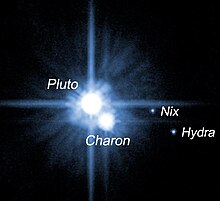
ತಿಳಿದಿರುವಂತೆ ಪ್ಲೂಟೊ ಮೂರು ಸ್ವಾಭಾವಿಕ ಉಪಗ್ರಹಗಳನ್ನು ಹೊಂದಿದೆ: ೧೯೭೮ರಲ್ಲಿ ಕಂಡು ಹಿಡಿಯಲಾದ ಶಾರನ್; ೨೦೦೫ರಲ್ಲಿ ಬೆಳಕಿಗೆ ಬಂದ ಎರಡು ಸಣ್ಣ ಉಪಗ್ರಹಗಳಾದ ನಿಕ್ಸ್ ಮತ್ತು ಹೈಡ್ರಾ.[೭೦]
ತಿಳಿದಿರುವ ಬೇರೆ ವ್ಯವಸ್ಥೆಗಳಿಗೆ ಹೋಲಿಸಿದರೆ, ಪ್ಲೂಟೊದ ಉಪಗ್ರಹಗಳು ಪ್ಲೂಟೊಗೆ ಅಸಾಮಾನ್ಯವಾಗಿ ಹತ್ತಿರದಲ್ಲಿವೆ. ಉಪಗ್ರಹಗಳು ಸಂಭಾವ್ಯವಾಗಿ ಹಿಲ್ಸ್ ಗೋಳದ (ಪ್ಲೂಟೊದ ಗುರುತ್ವ ಪ್ರಭಾವವು ಸ್ಥಿರವಾಗಿರುವ ದೂರವನ್ನಾವರಿಸಿರುವ ಒಂದು ಕಾಲ್ಪನಿಕ ಗೋಳ) ತ್ರಿಜ್ಯದ ೫೩% ತ್ರಿಜ್ಯದವರೆಗೆ (ಅಥವ, ಕಕ್ಷೆಯು ಅಪರಗಾಮಿಯಾಗಿದ್ದಲ್ಲಿ, ೬೯%) ಪ್ಲೂಟೊವನ್ನು ಪರಿಭ್ರಮಿಸಬಹುದು. ಉದಾರಹಣೆಗೆ, ಸಮಾತೆಯು ನೆಪ್ಚೂನ್ನನ್ನು ಹಿಲ್ ತ್ರಿಜ್ಯದ ೪೦% ದೂರದಲ್ಲಿ ಪರಿಭ್ರಮಿಸುತ್ತದೆ. ಪ್ಲೂಟೊದ ಸನ್ನಿವೇಶದಲ್ಲಿ, ವಲಯದ ಕೇವಲ ಒಳ ೩% ಭಾಗದಲ್ಲಿ ಉಪಗ್ರಹಗಳು ಕಾಣಬರುತ್ತವೆ. ಆವಿಷ್ಕಾರಕರ ಮಾತುಗಳಲ್ಲಿ ಹೇಳುವುದಾದರೆ, ಪ್ಲೂಟೊದ ವ್ಯವಸ್ಥೆಯು "ಬಹಳ ನಿಬಿಡವಾಗಿ ಮತ್ತು ಬಹಳಷ್ಟು ಖಾಲಿಯಾಗಿ" ಕಂಡು ಬರುತ್ತದೆ.[೭೧]
ಶಾರನ್
ಸೌರಮಂಡಲದಲ್ಲಿರುವ ಕೆಲವೇ ಜೋಡಿ ವ್ಯವಸ್ಥೆಗಳಲ್ಲಿ (ಅಂದರೆ, ವ್ಯವಸ್ಥೆಯ ಭಾರಕೇಂದ್ರವು ಮುಖ್ಯ ಕಾಯದ ಹೊರಗಿರುತ್ತದೆ) ಪ್ಲೂಟೊ-ಶಾರನ್ ಅತಿ ದೊಡ್ಡದು.[೭೨] ಈ ವಾಸ್ತವಾಂಶ ಮತ್ತು ಪ್ಲುಟೊಗೆ ಸಾಪೇಕ್ಷವಾಗಿ ಶಾರನ್ನ ದೊಡ್ಡ ಗಾತ್ರಗಳ ಕಾರಣದಿಂದ, ಕೆಲವು ಖಗೋಳಶಾಸ್ತ್ರಜ್ಞರು ಇದನ್ನು ಕುಬ್ಜ ಗ್ರಹ ಜೋಡಿ ಎಂದು ಕರೆಯುತ್ತಾರೆ.[೭೩] ಗ್ರಹ ವ್ಯವಸ್ಥೆಗಳಲ್ಲೂ ಈ ವ್ಯವಸ್ಥೆಯು ವಿಶಿಷ್ಟವಾಗಿದ್ದು, ಇಲ್ಲಿ ಪ್ರತಿ ಕಾಯವೂ ಇನ್ನೊಂದಕ್ಕೆ ಉಬ್ಬರವಿಳಿತದ ಹಿಡಿತದಲ್ಲಿ ಸಿಲುಕಿಕೊಂಡಿದೆ: ಶಾರನ್ನ ಒಂದೇ ಮುಖವು ಎಂದಿಗೂ ಪ್ಲೂಟೊದ ಕಡೆಗೆ ತಿರುಗಿದ್ದು, ಪ್ಲೂಟೊದ ಒಂದೇ ಮುಖವು ಶಾರನ್ನ ಕಡೆ ತಿರುಗಿರುತ್ತದೆ. ಅಂದರೆ, ಪ್ಲೂಟೊದ ದೂರದ ಮುಖದಲ್ಲಿರುವ ವೀಕ್ಷಕನೊಬ್ಬನಿಗೆ ಶಾರನ್ ಎಂದೂ ಗೋಚರಿಸುವುದೇ ಇಲ್ಲ.[೭೪] ೨೦೦೭ರಲ್ಲಿ ಜೆಮಿನಿ ವೀಕ್ಷಣಾಲಯವು ಶಾರನ್ನ ಮೇಲ್ಮೈ ಮೇಲೆ ಅಮೋನಿಯ ಹೈಡ್ರೇಟುಗಳು ಮತ್ತು ನೀರಿನ ಸ್ಫಟಿಕಗಳನ್ನು ವೀಕ್ಷಿಸಿ ಸಕ್ರಿಯ ಶೈತ್ಯ-ಗೀಸರ್ಗಳ ಅಸ್ತಿತ್ವವನ್ನು ಸೂಚಿಸಿತು.[೭೫]
| ಹೆಸರು | ವ್ಯಾಸ (ಕಿ.ಮೀ.) | ದ್ರವ್ಯರಾಶಿ (ಕಿ.ಗ್ರಾಂ.) | ಕಕ್ಷೀಯ ತ್ರಿಜ್ಯ (ಕಿ.ಮೀ.) (ಭಾರಕೇಂದ್ರೀಯ) | ಕಕ್ಷೀಯ ಅವಧಿ (ದಿನ) |
|---|---|---|---|---|
| ಪ್ಲೂಟೊ | ೨೩೦೬ (ಚಂದ್ರನ ೬೫%) | ೧.೩೦೫ (೭) ×೧೦೨೨ (ಚಂದ್ರನ ೧೮%) | ೨,೦೪೦ (೧೦೦) (ಚಂದ್ರನ ೦.೬%) | ೬.೩೮೭೨ (ಚಂದ್ರನ ೨೫%) |
| ಶಾರನ್ | ೧೨೦೫ (ಚಂದ್ರನ ೩೫%) | ೧.೫೨ (೭)×೧೦೨೧ (ಚಂದ್ರನ ೨%) | ೧೭,೫೩೦ (೯೦) (ಚಂದ್ರನ ೫%) |
ನಿಕ್ಸ್ ಮತ್ತು ಹೈಡ್ರಾ
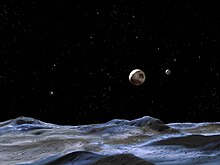

ಮೇ ೧೫, ೨೦೦೫ರಂದು ಹಬಲ್ ದೂರದರ್ಶಕದೊಡನೆ ಕೆಲಸ ಮಾಡುತ್ತಿದ್ದ ಖಗೋಳಶಾಸ್ತ್ರಜ್ಞರು ಪ್ಲುಟೊದ ಎರಡು ಹೊಸ ಉಪಗ್ರಹಗಳನ್ನು ಪತ್ತೆ ಹೆಚ್ಚಿದರು. ಇವುಗಳಿಗೆ ತಾತ್ಕಾಲಿಕವಾಗಿ S/2005 P 1 ಮತ್ತು S/2005 P 2 ಎಂಬ ಹೆಸರುಗಳನ್ನು ನಿಯೋಜಿಸಲಾಯಿತು. ಜೂನ್ ೨೧, ೨೦೦೬ರಂದು ಅಂ.ಖ.ಸಂ.ಯು ಪ್ಲೂಟೊದ ಉಪಗ್ರಹಗಳಿಗೆ ಅಧಿಕೃತವಾಗಿ ನಿಕ್ಸ್ (ಅಥವ ಪ್ಲೂಟೊ II - ಎರಡು ಉಪಗ್ರಹಗಳಲ್ಲಿ ಒಳಗಡೆಯದು - ಮುಂಚಿನ ಹೆಸರು P 2) ಮತ್ತು ಹೈಡ್ರಾ (ಪ್ಲೂಟೊ III - ಹೊರ ಉಪಗ್ರಹ - ಮುಂಚೆ P 1) ಎಂದು ನಾಮಕರಣ ಮಾಡಿತು.[೭೭]
ಈ ಸಣ್ಣ ಉಪಗ್ರಹಗಳು ಪ್ಲೂಟೊವನ್ನು ಶಾರನ್ನ ಸುಮಾರು ಎರಡು ಮತ್ತು ಮೂರು ಪಟ್ಟು ದೂರದಲ್ಲಿ ಪರಿಭ್ರಮಿಸುತ್ತವೆ. ವ್ಯವಸ್ಥೆಯ ಭಾರಕೇಂದ್ರದಿಂದ ನಿಕ್ಸ್ ೪೮,೭೦೦ ಕಿ.ಮೀ. ಮತ್ತು ಹೈಡ್ರಾ ೬೪,೮೦೦ ಕಿ.ಮೀ. ದೂರದಲ್ಲಿ ಪರಿಭ್ರಮಿಸುತ್ತವೆ. ಇವು ಸುಮಾರು ವೃತ್ತಾಕಾರದ ಅಭಿಗಾಮಿ ಚಲನೆಯನ್ನು ಹೊಂದಿದ್ದು, ಶಾರನ್ನ ಕಕ್ಷಾ ಸಮತಳದಲ್ಲೇ ಇವೆ. ಇವು ಶಾರನ್ನೊಂದಿಗೆ ಸುಮಾರು (ಆದರೆ, ನಿಖರವಾಗಲ್ಲ) ೪:೧ ಮತ್ತು ೬:೧ ಸರಾಸರಿ ಚಲನೆಯ ಕಕ್ಷೀಯ ಅನುರಣನೆಯಲ್ಲಿವೆ.[೭೮]
ನಿಕ್ಸ್ ಮತ್ತು ಹೈಡ್ರಾಗಳ ವಿಶಿಷ್ಟ ಗುಣಲಕ್ಷಣಗಳನ್ನು ಕಂಡುಹಿಡಿಯಲ್ಲಿ ಇನ್ನೂ ಅವುಗಳ ವೀಕ್ಷಣೆಗಳನ್ನು ನಡೆಸಲಾಗುತ್ತಿದೆ. ಹೈಡ್ರಾ ಒಮ್ಮೊಮ್ಮೆ ನಿಕ್ಸ್ಗಿಂತ ಹೆಚ್ಚು ಪ್ರಕಾಶಮಾನವಾಗಿರುತ್ತದೆ - ಇದರಿಂದ, ಹೈಡ್ರಾ ನಿಕ್ಸ್ಗಿಂತ ದೊಡ್ಡದು ಅಥವ ಅದರ ಮೇಲ್ಮೈನ ಬೇರೆ ಬೇರೆ ಭಾಗಗಳು ವಿವಿಧ ಪ್ರಕಾಶತೆಯನ್ನು ಹೊಂದಿರಬಹುದು ಎಂದು ತಿಳಿದು ಬರುತ್ತದೆ. ಗಾತ್ರಗಳನ್ನು ಪ್ರತಿಫಲನಾಂಶಗಳಿಂದ ಅಂದಾಜು ಮಾಡಲಾಗುತ್ತದೆ. The moons' spectral similarity to Charon suggests a 35% albedo similar to Charon's; this value results in diameter estimates of 46 kilometres for Nix and 61 kilometres for the brighter Hydra. Upper limits on their diameters can be estimated by assuming the 4% albedo of the darkest Kuiper Belt objects; these bounds are 137 ± 11 km and 167 ± 10 km, respectively. At the larger end of this range, the inferred masses are less than 0.3% that of Charon, or 0.03% of Pluto's.[೭೯]
The discovery of the two small moons suggests that Pluto may possess a variable ring system. Small body impacts can create debris that can form into planetary rings. Data from a deep optical survey by the Advanced Camera for Surveys on the Hubble Space Telescope suggest that no ring system is present. If such a system exists, it is either tenuous like the rings of Jupiter or is tightly confined to less than 1000 km in width.[೮೦]
In imaging the Plutonian system, observations from Hubble placed limits on any additional moons. With 90% confidence, no additional moons larger than 12 km (or a maximum of 37 km with an albedo of 0.041) exist beyond the glare of Pluto 5 arcseconds from the dwarf planet. This assumes a Charon-like albedo of 0.38; at a 50% confidence level the limit is 8 kilometres.[೮೧]
ಕೈಪರ್ ಪಟ್ಟಿ
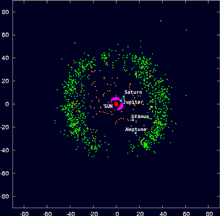
ಪ್ಲೂಟೊದ ಮೂಲ ಮತ್ತು ನಿಜರೂಪಗಳು ಬಹಳ ವರ್ಷಗಳಿಂದ ಖಗೋಳಶಾಸ್ತ್ರಜ್ಞರನ್ನು ತಬ್ಬಿಬ್ಬುಗೊಳಿಸಿವೆ. ಪ್ಲುಟೊ ಮುಂಚೆ ನೆಪ್ಚೂನ್ನ ಉಪಗ್ರಹವಾಗಿತ್ತೆಂದೂ, ಹಾಗು ನೆಪ್ಚೂನ್ನ ಅತಿ ದೊಡ್ಡ ಉಪಗ್ರಹವಾದ ಟ್ರಿಟಾನ್ ಪ್ಲೂಟೊವನ್ನು ಕಕ್ಷೆಯಿಂದ ತಳ್ಳಿಹಾಕಿತೆಂದೂ, ೫೦ರ ದಶಕದಲ್ಲಿ ಸೂಚಿಸಲಾಗಿತ್ತು. ಆದರೆ ಈ ಮೇಲೆ ವಿವರಿಸಲಾದಂತೆ, ಪ್ಲೂಟೊ ವಾಸ್ತವದಲ್ಲಿ ನೆಪ್ಚೂನ್ನ ಹತ್ತಿರವೇ ಬರುವುದಿಲ್ಲವಾದ್ದರಿಂದ, ಈ ಕಲ್ಪನೆಯನ್ನು ವ್ಯಾಪಕವಾಗಿ ಟೀಕಿಸಲಾಗಿದೆ.[೮೨]
Beginning in 1992, astronomers began to discover a large population of small icy objects beyond Neptune that were similar to Pluto not only in orbit but also in size and composition. This belt, known as the Kuiper belt after one of the astronomers who first speculated on the nature of a trans-Neptunian population, is believed to be the source of many short-period comets. ಖಗೋಳಶಾಸ್ತ್ರಜ್ಞರ ಪ್ರಸ್ತುತದ ನಂಬಿಕೆಯ ಪ್ರಕಾರ, ಪ್ಲೂಟೊ ತಿಳಿದಿರುವ ಕೈಪರ್ ಪಟ್ಟಿ ಕಾಯಗಳಲ್ಲಿ ಅತಿ ದೊಡ್ಡದು. ಬೇರೆ ಕೈಪರ್ ಪಟ್ಟಿ ಕಾಯಗಳಂತೆ, ಪ್ಲುಟೊ ಸಹ ಧೂಮಕೇತುಗಳ ಹಲವು ಗುಣಲಕ್ಷಣ ಗಳನ್ನು ಹೊಂದಿದೆ; ಉದಾಹರಣೆಗೆ, ಸೌರ ಮಾರುತವು ಪ್ಲೂಟೊದ ಮೇಲ್ಮೈಯನ್ನು ನಿಧಾನವಾಗಿ ಧೂಳೆಬ್ಬಿಸಿ ಬಾಹ್ಯಾಕಾಶಕ್ಕೆ ಬೀಸುತ್ತಿದೆ. ಧೂಮಕೇತುಗಳಲ್ಲೂ ಇದೇ ಥರದ ಪ್ರಕ್ರಿಯೆಯು ನಡೆಯುತ್ತದೆ.[೮೩] ಪ್ಲೂಟೊ ಸೂರ್ಯನ ಹತ್ತಿರವಿದ್ದಿದ್ದರೆ ಅದಕ್ಕೆ ಧೂಮಕೇತುಗಳಂತೆಯೇ ಒಂದು ಬಾಲ ವಿರುತ್ತಿತ್ತು.[೮೪]
ಪ್ಲೂಟೊ ಇದುವರೆಗೆ ತಿಳಿದ ಅತಿ ದೊಡ್ಡ ಕೈಪರ್ ಪಟ್ಟಿ ಕಾಯವಾದರೂ, ಪ್ಲೂಟೊಗಿಂತ ಸ್ವಲ್ಪ ದೊಡ್ಡದಾಗಿದ್ದು, ಪ್ಲೂಟೊದಂತೆಯೇ ಹಲವು ವಾಯುಮಂಡಲದ ಮತ್ತು ಭೂವೈಜ್ಞಾನಿಕ ಗುಣಲಕ್ಷಣಗಳನ್ನು ಹೊಂದಿರುವ ಟ್ರಿಟಾನ್ ಒಂದು ಸೆರೆ ಹಿಡಿಯಲಾದ ಕೈಪರ್ ಪಟ್ಟಿ ಕಾಯವೆಂದು ನಂಬಲಾಗಿದೆ.[೮೫] Eris (see below) is also larger than Pluto but is not strictly considered a member of the Kuiper belt population. ಬದಲಿಗೆ, ಇದನ್ನು ಸಂಬಂಧಿತ ಚದರಿದ ತಟ್ಟೆಯ ಒಂದು ಸದಸ್ಯವೆಂದು ಪರಿಗಣಿಸಲಾಗುತ್ತದೆ.
ಪ್ಲೂಟೊನಂತಹ ಬಹಳಷ್ಟು ಕೈಪರ್ ಪಟ್ಟಿ ಕಾಯಗಳು ನೆಪ್ಚೂನ್ನೊಂದಿಗೆ ೩:೨ ಕಕ್ಷೀಯ ಅನುರಣನೆಯನ್ನು ಹೊಂದಿವೆ. ಈ ಅನುರಣನೆಯನ್ನು ಹೊಂದಿರುವ ಕೈಪರ್ ಪಟ್ಟಿ ಕಾಯಗಳನ್ನು "ಪ್ಲುಟೀನೊ"ಗಳೆಂದು ಕರೆಯಲಾಗುತ್ತದೆ.[೮೬]
ಪ್ಲೂಟೊದ ಅನ್ವೇಷಣೆ

ತನ್ನ ಅಲ್ಪ ದ್ರವ್ಯರಾಶಿ ಮತ್ತು ಭೂಮಿಯಿಂದ ಅಪಾರ ದೂರಗಳ ಕಾರಣ, ಪ್ಲೂಟೊ ಗಗನನೌಕೆಗಳಿಗೆ ಗಮನಾರ್ಹ ಸಮಸ್ಯೆಗಳನ್ನೊಡ್ಡುತ್ತದೆ. ವಾಯೇಜರ್ ೧ ಪ್ಲೂಟೊವನ್ನು ತಲುಪಬಹುದಾಗಿತ್ತಾದರೂ ಅದರ ಅಭಿಯಂತರರು ಅದನ್ನು ಶನಿಯ ಉಪಗ್ರಹವಾದ ಟೈಟನ್ನತ್ತ ಕಳುಹಿಸಲು ನಿರ್ಧರಿಸಿದ್ದರಿಂದ, ನೌಕೆಯ ಪಥವು ಪ್ಲುಟೊವನ್ನು ತಲುಪಲು ಸಾಧ್ಯವಾಯಿತು. ವಾಯೇಜರ್ ೨ ನೌಕೆಯು ಪ್ಲೂಟೊವನ್ನು ತಲುಪುವಂತಹ ಸಂಭಾವ್ಯ ಪಥವನ್ನೇ ಹೊಂದಿರಲಿಲ್ಲ.[೮೭]
೨೦ನೇ ಶತಮಾನದ ಕೊನೆಯವರೆಗೆ ಪ್ಲೂಟೊವನ್ನು ಗಗನನೌಕೆಯಿಂದ ಅನ್ವೇಷಿಸಲು ಯಾವುದೇ ಗಂಭೀರ ಪ್ರಯತ್ನಗಳು ನಡೆಯಲಿಲ್ಲ. In August 1992, JPL scientist Robert Staehle telephoned Pluto's discoverer, Clyde Tombaugh, requesting permission to visit his planet. "I told him he was welcome to it," Tombaugh later remembered, "though he's got to go one long, cold trip."[೮೮] ಈ ಹುಮ್ಮಸ್ಸಿನ ನಂತರವೊ, ೨೦೦೦ದಲ್ಲಿ ಹೆಚ್ಚುತ್ತಿದ್ದ ವೆಚ್ಚಗಳು ಮತ್ತು ಉಡಾವಣಾ ವಾಹನದ ತೊಂದರೆಗಳ ಕಾರಣದಿಂದ ನಾಸಾ ತನ್ನ ಪ್ಲುಟೊ ಕೈಪರ್ ಯಾತ್ರೆಯನ್ನು ರದ್ದುಗೊಳಿಸಿತು.[೮೯]
ತೀವ್ರವಾದ ರಾಜಕೀಯ ಗೊಂದಲಗಳ ನಂತರ, ೨೦೦೩ರಲ್ಲಿ ನವ ದಿಗಂತ ಎಂಬ ಹೆಸರಿನ ಪರಿಷ್ಕೃತ ಪ್ಲೂಟೊ ಯಾತ್ರೆಗೆ ಅಮೆರಿಕಾ ಸರ್ಕಾರದ ಪುದುವಟ್ಟು ದೊರಕಿತು.[೯೦] ನವ ದಿಗಂತವನ್ನು ೨೦೦೬ರ ಜನವರಿ ೧೯ರಂದು ಯಶಸ್ವಿಯಾಗಿ ಉಡಾಯಿಸಲಾಯಿತು. The mission leader, S. Alan Stern, confirmed that some of the ashes of Clyde Tombaugh, who died in 1997, had been placed aboard the spacecraft.[೯೧]
In early 2007 the craft made use of a gravity assist from Jupiter. ಇದು ೨೦೧೫ರ ಜುಲೈ ೧೪ರಂದು ಪ್ಲೂಟೊಗೆ ಅತಿ ಹತ್ತಿರದಲ್ಲಿ ಹಾದುಹೋಗಲಿದೆ; ಈ ಹಾಯುವಿಕೆಯ ೫ ತಿಂಗಳುಗಳ ಮುಂಚೆಯಿಂದ ಪ್ಲೂಟೊದ ವೈಜ್ಞಾನಿಕ ವೀಕ್ಷಣೆಗಳು ಆರಂಭವಾಗಿ ಹಾಯುವಿಕೆಯ ನಂತರ ಕಡೇ ಪಕ್ಷ ಒಂದು ತಿಂಗಳವರೆಗೆ ನಡೆಯಲಿವೆ. New Horizons captured its first (distant) images of Pluto in late September 2006, during a test of the Long Range Reconnaissance Imager (LORRI).[೯೨] The images, taken from a distance of approximately 4.2 billion kilometres, confirm the spacecraft's ability to track distant targets, critical for maneuvering toward Pluto and other Kuiper Belt objects.
New Horizons will use a remote sensing package that includes imaging instruments and a radio science investigation tool, as well as spectroscopic and other experiments, to characterise the global geology and morphology of Pluto and its moon Charon, map their surface composition and analyse Pluto's neutral atmosphere and its escape rate. ನವ ದಿಗಂತವು ಪ್ಲೂಟೊ ಮತ್ತು ಶಾರನ್ಗಳ ಮೇಲ್ಮೈ ಛಾಯಾಚಿತ್ರಗಳನ್ನೂ ತೆಗೆಯಲಿದೆ.
Discovery of moons Nix and Hydra may present unforeseen challenges for the probe. Debris from collisions between Kuiper belt objects and the smaller moons, with their relatively low escape velocities, may produce a tenuous dusty ring. Were New Horizons to fly through such a ring system, there would be an increased potential for micrometeorite damage that could disable the probe.[೮೦]
ಗ್ರಹ ಸ್ಥಾನಮಾನದ ವಿವಾದ
೧೯೯೨ರಲ್ಲಿ ಮೊದಲ ಕೈಪರ್ ಪಟ್ಟಿ ಕಾಯವಾದ en:(15760) 1992 QB1ರ ಆವಿಷ್ಕರಣೆಯಿಂದ ಶುರುವಾಗಿ ಪ್ಲೂಟೊದ ಗ್ರಹ ಸ್ಥಾನಮಾನವು ವಿವಾದಕ್ಕೊಳಪಟ್ಟಿದೆ. ಆಗಿನಿಂದ ನಡೆದ ಮುಂದಿನ ಆವಿಷ್ಕರಣೆಗಳು ಈ ವಿವಾದವನ್ನು ತೀವ್ರಗೊಳಿಸಿವೆ.
Commemoration as a planet
Pluto is shown as a planet on the Pioneer plaque, an inscription on the space probes Pioneer 10 and Pioneer 11, launched in the early 1970s. The plaque, intended to give information about the origin of the probes to any alien civilization that might in the future encounter the vehicles, includes a diagram of our solar system, showing nine planets.[೯೩] Similarly, an analog image contained within the Voyager Golden Record included on the probes Voyager 1 and Voyager 2 (also launched in the 1970s) includes data regarding Pluto and again shows it as the ninth planet.[೯೪] The Disney character Pluto, introduced in 1930, was also named in honour of the planet.[೯೫] In 1941, Glenn T. Seaborg named the newly created element plutonium in Pluto's honour, in keeping with the tradition of naming elements after newly discovered planets (uranium after Uranus and neptunium after Neptune, although this tradition is also used for some non-planets: cerium is named after Ceres and palladium after Pallas).[೯೬]
ಹೊಸ ಆವಿಷ್ಕಾರಗಳಿಂದ ಭುಗಿಲೆದ್ದ ವಿವಾದಗಳು
ದೋಷ:ಪ್ರಥಮ ಸಾಲಿನಲ್ಲಿ ಒಂದು ಚಿತ್ರವನ್ನು ಖಚಿತವಾಗಿ ನಮೂದಿಸಬೇಕು
The discovery of the Kuiper belt and Pluto's relation to it led many to question whether Pluto could be considered separately from others in its population. ೨೦೦೨ರಲ್ಲಿ ಕೈಪರ್ ಪಟ್ಟಿ ಕಾಯವಾದ ೫೦೦೦೦೦ ಕ್ವಾವಾರ್ ಬೆಳಕಿಗೆ ಬಂದಿತು; ಇದರ ೧,೨೮೦ ಕಿ.ಮೀ. ವ್ಯಾಸವು ಪ್ಲುಟೊದ ವ್ಯಾಸದ ಸುಮಾರು ಅರ್ಧದಷ್ಟಿದೆ.[೯೭] In 2004, the discoverers of 90377 Sedna placed an upper limit of 1,800 kilometres on its diameter, near Pluto's diameter of 2,320 kilometres.[೯೮] ಇತರೆ ಕ್ಷುದ್ರ ಗ್ರಹಗಳ ಆವಿಷ್ಕಾರದ ನಂತರ ಸೆರೆಸ್ ತನ್ನ ಗ್ರಹ ಸ್ಥಾನಮಾನವನ್ನು ಕಳೆದುಕೊಂಡಂತೆಯೇ, ಪ್ಲೂಟೊವನ್ನು ಒಂದು ಕೈಪರ್ ಪಟ್ಟಿ ಕಾಯವೆಂದು ವಿಂಗಡಿಸಬೇಕೆಂದು ವಾದಿಸಲಾಯಿತು.
೨೦೦೫ರ ಜುಲೈ ೨೯ರಂದು ಒಂದು ಹೊಸ ನೆಪ್ಚೂನಾತೀತ ಕಾಯದ ಆವಿಷ್ಕಾರವನ್ನು ಘೋಷಿಸಲಾಯಿತು. ಈರಿಸ್ ಎಂಬ ಹೆಸರಿನ ಈ ಕಾಯವು ಪ್ಲೂಟೊಗಿಂತ ಸ್ವಲ್ಪ ದೊಡ್ಡದಾಗಿದೆ ಎಂದು ಈಗ ತಿಳಿದಿದೆ.[೯೯]
೧೮೪೬ರಲ್ಲಿ ಟ್ರಿಟಾನ್ನ ಆವಿಷ್ಕಾರದ ನಂತರ ಮತ್ತು ೨೦೦೫ಕ್ಕೆ ಮುಂಚೆ ಸೌರಮಂಡಲದಲ್ಲಿ ಈರಿಸ್ನಷ್ಟು ದೊಡ್ಡ ಬೇರಾವುದೇ ಕಾಯವನ್ನು ಕಂಡುಹಿಡಿಯಲಾಗಿರಲಿಲ್ಲ. ಈರಿಸ್ನ ಬಗ್ಗೆ ಯಾವುದೇ ಅಧಿಕೃತ ಸಮ್ಮತಿಯಿರದಿದ್ದರೂ, ಅದರ ಆವಿಷ್ಕಾರಕರು ಮತ್ತು ಸುದ್ದಿ ಮಾಧ್ಯಮಗಳು ಮೊದಮೊದಲು ಅದನ್ನು "ಹತ್ತನೆಯ ಗ್ರಹ" ಎಂದೇ ಕರೆದರು.[೧೦೦] ಈರಿಸ್ನ ಆವಿಷ್ಕಾರವು ಪ್ಲುಟೊದ ಮರುವಿಂಗಡಣೆಗೆ ಒಂದು ಪ್ರಬಲ ವಾದವೆಂದೇ ಖಗೋಳಶಾಸ್ತ್ರೀಯ ಸಮುದಾಯದ ಕೆಲವರು ಪರಿಗಣಿಸಿದರು.[೧೦೧]
ಇಷ್ಟು ಹೊತ್ತಿಗೆ ಪ್ಲುಟೊನಲ್ಲಿ ಕಡೆಗುಳಿದ ವಿಶಿಷ್ಟ ಲಕ್ಷಣಗಳೆಂದರೆ ಅದರ ವಾಯುಮಂಡಲ ಮತ್ತು ಅದರ ದೊಡ್ಡ ಉಪಗ್ರಹ ಶಾರನ್. ಈ ಲಕ್ಷಣಗಳು ಬಹುಶಃ ಪ್ಲುಟೊಗೆ ವಿಶಿಷ್ಟವೇ ಅಲ್ಲ: ಹಲವು ಇತರೆ ನೆಪ್ಚೂನಾತೀತ ಕಾಯಗಳು ಉಪಗ್ರಹಗಳನ್ನು ಹೊಂದಿವೆ, ಮತ್ತು ಈರಿಸ್ನ ರೋಹಿತದಿಂದ ಅದರ ಮೇಲ್ಮೈಯು ಪ್ಲುಟೊದಂತೆಯೇ ರಚಿತವಾಗಿದೆಯೆಂದು ತಿಳಿದುಬರುತ್ತದೆ.[೧೦೨]
ಸೆಪ್ಟೆಂಬರ್ ೨೦೦೫ರಲ್ಲಿ ಕಂಡು ಹಿಡಿಯಲಾದ ಡಿಸ್ನೋಮಿಯ ಎಂಬ ಉಪಗ್ರಹವು ಈರಿಸ್ನನ್ನು ಪರಿಭ್ರಮಿಸುತ್ತದೆ. Trans-Neptunian object 2003 EL61 (nicknamed "Santa") has two moons (one of which is nicknamed "Rudolph") and is the fourth largest TNO behind Eris, Pluto, and 2005 FY9 (nicknamed "Easterbunny").
ವಸ್ತು ಸಂಗ್ರಹಾಲಯ ಮತ್ತು ಖಗೋಳ ವೀಕ್ಷಣಾಲಯಗಳ ನಿರ್ದೇಶಕರು ಪ್ಲೂಟೊವನ್ನು ತಮ್ಮ ಗ್ರಹಮಂಡಲಗಳ ಮಾದರಿಗಳಿಂದ ಹೊರತುಪಡಿಸಿ ಒಮ್ಮೊಮ್ಮೆ ವಿವಾದಕ್ಕೆ ಎಡೆ ಮಾಡಿಕೊಟ್ಟರು. ಇವುಗಳಲ್ಲಿ ಕೆಲವು ಹೊರತುಪಡಿಕೆಗಳು ಉದ್ದೇಶಪೂರ್ವಕವಾಗಿದ್ದವು; ಹೇಯ್ಡನ್ ಖಗೋಳವೀಕ್ಷಣಾಲಯವು ೨೦೦೦ರಲ್ಲಿ ಜೀರ್ಣೋದ್ಧಾರದ ನಂತರ ಮತ್ತೆ ವೀಕ್ಷಣೆಗೆ ತೆಗೆದಾಗ ಅದರ ಗ್ರಹ ಮಾದರಿಯಲ್ಲಿ ಕೇವಲ ಎಂಟು ಗ್ರಹಗಳಿದ್ದವು. ಆ ಸಮಯದಲ್ಲಿ ವಿವಾದವು ಮುಖಪುಟ ಸುದ್ದಿಯಾಗಿತ್ತು.[೧೦೩]
ಪ್ಲೂಟೊ ಮರುವಿಂಗಡಣೆ - ಅಂತರರಾಷ್ಟ್ರೀಯ ಖಗೋಳಶಾಸ್ತ್ರೀಯ ಸಂಸ್ಥೆಯ ನಿರ್ಧಾರ
೨೦೦೬ರಲ್ಲಿ ಸಂಸ್ಥೆಯು ಗ್ರಹ ಪದಕ್ಕೆ ಒಂದು ಅಧಿಕೃತ ವ್ಯಾಖ್ಯಾನವನ್ನು ಸೃಷ್ಟಿಸಿತು. ಈ ನಿರ್ಣಯದ ಮೇರೆಗೆ, ಆಕಾಶಕಾಯವನ್ನು ಒಂದು 'ಗ್ರಹ'ವೆಂದು ಪರಿಗಣಿಸಲು ಅದು ಮುಖ್ಯವಾಗಿ ಮೂರು ಷರತ್ತುಗಳನ್ನು ಪಾಲಿಸಬೇಕು:
- ಕಾಯವು ಸೂರ್ಯನನ್ನು (ಅಥವಾ, ತನ್ನ ಹತ್ತಿರದ ನಕ್ಷತ್ರವನ್ನು) ಪರಿಭ್ರಮಿಸುತ್ತಿರಬೇಕು
- ಕಾಯವು ತನ್ನದೇ ಗುರುತ್ವ ಬಲದಿಂದ ಗೋಳಕಾರದಲ್ಲಿರುವಷ್ಟು ಭಾರಿಯಾಗಿರಬೇಕು. ವಿಶಿಷ್ಟವಾಗಿ, ತನ್ನದೇ ಗುರುತ್ವವು ಕಾಯವನ್ನು ದ್ರವ್ಯಸ್ಥಿತಿ ಸಮತೋಲನದ ಆಕಾರಕ್ಕೆ ತರಬೇಕು
- ಕಾಯವು ತನ್ನ ಕಕ್ಷೆಯ ನೆರೆಕೆರೆಯನ್ನು ತೆರವುಗೊಳಿಸಿರಬೇಕು.[೧೦೪]
ಪ್ಲೂಟೊದ ದ್ರವ್ಯರಾಶಿಯು ಅದರ ಕಕ್ಷೆಯಲ್ಲಿನ ಇತರೆ ಕಾಯಗಳ ಕೇವಲ ೭% ನಷ್ಟಿದ್ದು (ಹೋಲಿಕೆಯಲ್ಲಿ, ಭೂಮಿಯು ತನ್ನ ಕಕ್ಷೆಯ ಉಳಿದ ಕಾಯಗಳ ೧೭ ಲಕ್ಷ ಪಟ್ಟು ದ್ರವ್ಯರಾಶಿಯನ್ನು ಹೊಂದಿದೆ), ಈ ಮೇಲಿನ ಮೂರನೆಯ ಷರತ್ತು ಪ್ಲೂಟೊದ ಮೇಲೆ ವಿಫಲವಾಗುತ್ತದೆ.[೧೦೫][೧೦೬] ಇದಲ್ಲದೆ, ಆಗತಾನೆ ಸೃಷ್ಟಿತ ಹೊಸ ಕುಬ್ಜ ಗ್ರಹ ವರ್ಗಕ್ಕೆ ಪ್ಲುಟೊವನ್ನು ವಿಂಗಡಿಸಬೇಕು ಮತ್ತು ಇನ್ನೂ ಹೆಸರಿಲ್ಲದ ನೆಪ್ಚೂನ್ಅತೀತ ಕಾಯಗಳ ವರ್ಗಕ್ಕೆ ಪ್ಲುಟೊ ಮೊದಲ ಸದಸ್ಯವಾಗಬೇಕೆಂದು ಅಂ.ಖ.ಸಂ.ಯು ತೀರ್ಮಾನಿಸಿತು.
೨೦೦೬ರ ಸೆಪ್ಟೆಂಬರ್ ೧೩ರಂದು ಅಂ.ಖ.ಸಂ.ಯು ಪ್ಲೂಟೊ, ಎರಿಸ್, ಮತ್ತು ಎರಿಸ್ನ ಉಪಗ್ರಹವಾದ ಡಿಸ್ನೋಮಿಯ ಇವುಗಳನ್ನು ತನ್ನ ಗ್ರಹಾಭ ಕ್ಯಾಟ ಲಾಗಿಗೆ ಸೇರಿಸಿ, ಅವುಗಳಿಗೆ "(೧೩೪೩೪೦) ಪ್ಲೂಟೊ", "(೧೩೬೧೯೯) ಎರಿಸ್", ಮತ್ತು "(೧೩೬೧೯೯) ಎರಿಸ್ ೧ ಡಿಸ್ನೋಮಿಯ" ಎಂಬ ಅಧಿಕೃತ ಗ್ರಹಾಭ ಹೆಸರುಗಳನ್ನು ಒದಗಿಸಿತು.[೧೦೭] If Pluto had been given a minor planet name upon its discovery, the number would have been a little over a thousand rather than over 100,000. The first minor planet to be found after Pluto was 1164 Kobolda, a month later.
ಖಗೋಳಶಾಸ್ತ್ರೀಯ ಸಮುದಾಯದಲ್ಲಿ ಈ ಮರುವಿಂಗಡಣೆಗೆ ಇನ್ನೂ ಸ್ವಲ್ಪ ವಿರೋಧವಿದೆ.[೧೦೮][೧೦೯][೧೧೦] ಪ್ಲೂಟೊವರೆಗಿನ ಗಗನಯಾತ್ರೆ ನವ ದಿಗಂತದ ಮುಖ್ಯ ಪರೀಕ್ಷಕ ಆಲನ್ ಸ್ಟರ್ನ್ನು ಅಂ.ಖ.ಸಂ.ಯ ಈ ಮರುವಿಂಗಡಣೆ ನಿರ್ಧಾರವನ್ನು ಬಹಿರಂಗವಾಗಿ ಟೀಕಿಸಿ, "ತಾಂತ್ರಿಕ ಕಾರಣಗಳಿಂದಾಗಿ, ಇದೊಂದು ಕೆಟ್ಟ ವ್ಯಾಖ್ಯಾನ" ಎಂದು ಹೇಳಿದ್ದಾನೆ."[೧೧೧]
ಸ್ಟರ್ನ್ನ ಪ್ರಸ್ತುತದ ವ್ಯಾಜ್ಯವೆಂದರೆ, ಈ ಹೊಸ ವ್ಯಾಖ್ಯಾನದ ಪ್ರಕಾರ, ತಮ್ಮ ಕಕ್ಷೆಗಳಲ್ಲಿ ಕ್ಶುದ್ರಗಹಗಳನ್ನು ಹೊಂದಿರುವ ಭೂಮಿ, ಮಂಗಳ, ಗುರು ಮತ್ತು ನೆಪ್ಚೂನ್ಗಳನ್ನೆಲ್ಲ ಗ್ರಹಗಳಲ್ಲವೆಂದು ಪರಿಗಣಿಸಬೇಕಾಗುತ್ತದೆ.[೧೧೨] His other claim is that because less than five percent of astronomers voted for it, the decision was not representative of the entire astronomical community.[೧೧೨] Marc W. Buie of the Lowell observatory has voiced his opinion on the new definition on his website and is one of the petitioners against the definition.[೧೧೩] Others have supported the IAU. Mike Brown, the astronomer who discovered Eris, said "through this whole crazy circus-like procedure, somehow the right answer was stumbled on. It’s been a long time coming. Science is self-correcting eventually, even when strong emotions are involved."[೧೧೪]
ಸಾರ್ವಜನಿಕರಲ್ಲಿ ಈ ಹೊಸ ವ್ಯಾಖಾನವು ಮಿಶ್ರ ಪ್ರತಿಕ್ರಿಯೆಯನ್ನು ಉಂಟುಮಾಡಿದೆ. ಕೆಲವರು ಮರುವಿಂಗಡಣೆಯನ್ನು ಒಪ್ಪಿಕೊಂಡಿದ್ದಾರೆ; ಇನ್ನು ಕೆಲವರು ಅಹವಾಲುಗಳನ್ನು ಸಂಗ್ರಹಿಸಿ ಅಂ.ಖ.ಸಂ.ಯು ತನ್ನ ನಿರ್ಧಾರವನ್ನು ಹಿಂತೆಗೆಯುವಂತೆ ಒತ್ತಾಯಿಸಲು ಪ್ರಯತ್ನಿಸುತ್ತಿದ್ದಾರೆ.[೧೧೫] ಮತ್ತೆ ಕೆಲವರು ಭಾವುಕ ಕಾರಣಗಳಿಂದ ಬದಲಾವಣೆಯನ್ನು ತಿರಸ್ಕರಿಸಿ, ಮೊದಲಿನಿಂದ ಗ್ರಹವೆಂದೇ ಪರಿಚಿತವಾಗಿರುವ ಪ್ಲೂಟೊ ತಮಗೆ ಒಂದು ಗ್ರಹವಾಗಿಯೇ ಉಳಿಯುವುದೆಂದು ಹೇಳುತ್ತಾರೆ.[೧೧೬]
ಅಮೆರಿಕಾ ಪೌರರು ಆವಿಷ್ಕರಿಸಿದ ಏಕೈಕ ಗ್ರಹವಾದ ಪ್ಲೂಟೊದ ಸ್ತಿಥಿಯನ್ನು ಗ್ರಹವೆಂದೇ ಇಟ್ಟುಕೊಳ್ಳುವ ಸಲುವಾಗಿ ಈ ಎಲ್ಲ ವಿರೋಧಗಳು ನಡೆಯುತ್ತಿವೆ ಎಂದು ಬೇರೆ ಕೆಲವರ ಅಭಿಪ್ರಾಯ.[೧೧೭]
See also
- Pluto in fiction
- Pluto in astrology
- Solar eclipses on Pluto
- Pluto prototype
- Plutino
ಉಲ್ಲೇಖಗಳು
External links
| Find more about Pluto at Wikipedia's sister projects | |
 | Definitions and translations from Wiktionary |
 | Media from Commons |
 | Learning resources from Wikiversity |
 | Quotations from Wikiquote |
 | Source texts from Wikisource |
 | Textbooks from Wikibooks |
- Nunberg, G. (August 28, 2006). "Dwarfing Pluto". NPR.
{{cite web}}: Unknown parameter|lastaccess=ignored (help) An examination of the redefinition of Pluto from a linguistic perspective. - Pluto Profile Archived 2012-07-29 ವೇಬ್ಯಾಕ್ ಮೆಷಿನ್ ನಲ್ಲಿ. by NASA's Solar System Exploration
- "Lowell Observatory". 2007. Archived from the original on 2007-03-11. Retrieved 2008-01-12.
{{cite web}}: Unknown parameter|lastaccess=ignored (help) Website of the observatory that discovered Pluto - Williams, D. R. (September 7, 2006). "Pluto Fact Sheet". NASA.
{{cite web}}: Unknown parameter|lastaccess=ignored (help) - Dunn, T. (2006). "Pluto's 3:2 Resonance with Neptune". Gravity Simulator.
{{cite web}}: Unknown parameter|lastaccess=ignored (help) - Fraknoi, A. (2006). "Teaching What a Planet Is: A Roundtable on the Educational Implications of the New Definition of a Planet". Astronomy Education Review. Archived from the original on 2007-02-28. Retrieved 2008-01-12.
{{cite web}}: Unknown parameter|lastaccess=ignored (help) Series of personal articles written by astronomers involved in the debate. - "plutoed" - entries in the Urban Dictionary
- "pluto" v. - entries in the UrbanDictionary
| ನಮ್ಮ ಸೌರವ್ಯೂಹ |
| ಸೂರ್ಯ | ಬುಧ | ಶುಕ್ರ | ಭೂಮಿ (ಚಂದ್ರ) | ಮಂಗಳ | ಕ್ಷುದ್ರಗ್ರಹ ಹೊನಲು |
| ಗುರು | ಶನಿ | ಯುರೇನಸ್ | ನೆಪ್ಚೂನ್ | ಪ್ಲುಟೊ | ಕೈಪರ್ ಪಟ್ಟಿ | ಊರ್ಟ್ ಮೋಡ |
ಉಲ್ಲೇಖ ದೋಷ: <ref> tags exist for a group named "lower-alpha", but no corresponding <references group="lower-alpha"/> tag was found
